Construção Ambiente Turismo



The sound of tourism

 Carla Celestino Directora Director
Carla Celestino Directora Director
As temperaturas altas fizeram disparar as filas de automóveis a caminho das praias portuguesas e ainda não estávamos em Maio. Os termómetros foram baixando mas não dissuadiram o optimismo generalizado que antecipava a época balnear de 2023. Junho trouxe uma quarta vaga de calor. Tal como o tempo, assim é o barómetro do turismo: com altos e baixos.
De um lado temos os profissionais do sector todos animados com o aumento dos turistas nacionais e oriundos de Espanha, Estados Unidos da América, Reino Unido, França, Alemanha e Brasil. Com o fim da pandemia espera-se também o regresso dos turistas asiáticos.
2023 será melhor do que 2019 e 2022 em termos de taxa de operação, tarifa média por quarto (ARR - Average Room Rate) e receitas na hotelaria, diz a Associação de Hotelaria de Portugal.
À que abrir os cordões à bolsa, porque “ir” é o melhor remédio. E a economia agradece. Mas num país onde a gastronomia é rainha, por vezes há grandes caldeiradas. Num tacho bem cheio de condimentos nunca falta uma pitada picante e polémica da TAP, enquanto em lume brando encontra-se o novo Aeroporto de Lisboa. A esta receita tenta-se evitar acrescentar um pacote de “Mais Habitação”, pois, como sabemos, deu raia quer para o Alojamento Local, quer para os Vistos Gold para unidades turísticas.
Mas, como dizem os nossos patrícios brasileiros: “Barriga cheia, pé na areia!” Escolha é bem a praia. Isto porque a Quercus atribuiu este ano menos 47 praias com Qualidade de Ouro. Ainda assim, não fique preocupado pois tem 393 praias excepcionais à escolha.
The elevated temperatures have swollen the lines of traffic heading in the direction of Portugal’s beaches. The thermometers have been going down but have not put a damper on the general optimism in the build up to the 2023 summer seaside season. June brought a fourth heat wave. The barometer of tourism is just like the weather: with highs and lows.
On one side we have sector professionals all fired up with the increase of national tourists and those from Spain, United States, United Kingdom. France, Germany, and Brazil. With the end of the pandemic the return of Asian tourists is also expected.
2023 will be better than 2019 and 2022 in terms of the Occupation Rate, Average Room Rate (ARR) and hotel revenues, says the Portugal Hotels Association. (AHP)

So, loosen your purse strings because going on holiday is the best remedy. And it’s good for the economy.
But in a country where cuisine is queen, sometimes it’s a dog’s dinner. In a well-seasoned stew, there is always a pinch of spice and TAP controversy, while the new Lisbon Airport simmers on the backburner. Be careful not to add the ‘More Housing’ package to your stew because as we all know, it spoiled the Local Accommodation and Golden Visas for tourist homes.
But as our Portuguese-speaking cousins say: “Full belly, toes in the sand!” Choose your beach and choose wisely. That is because this year the environmental group Quercus has awarded 47 fewer Gold Quality designations than last year. Nevertheless, don’t worry, there are 393 exceptional to choose from.
Ficha técnica Datasheet
Propriedade Property Palavras Aliadas Sociedade Unipessoal, Lda. NIPC – 510 653 901
Gerência Anabela Loureiro
Rua Paulo Reis Gil nº 39, 3º Esq. 2745-195 Queluz
Telm. / Mobile: (+351) 96 237 00 08 geral@palavrasaliadas.pt www.magazineimobiliario.com
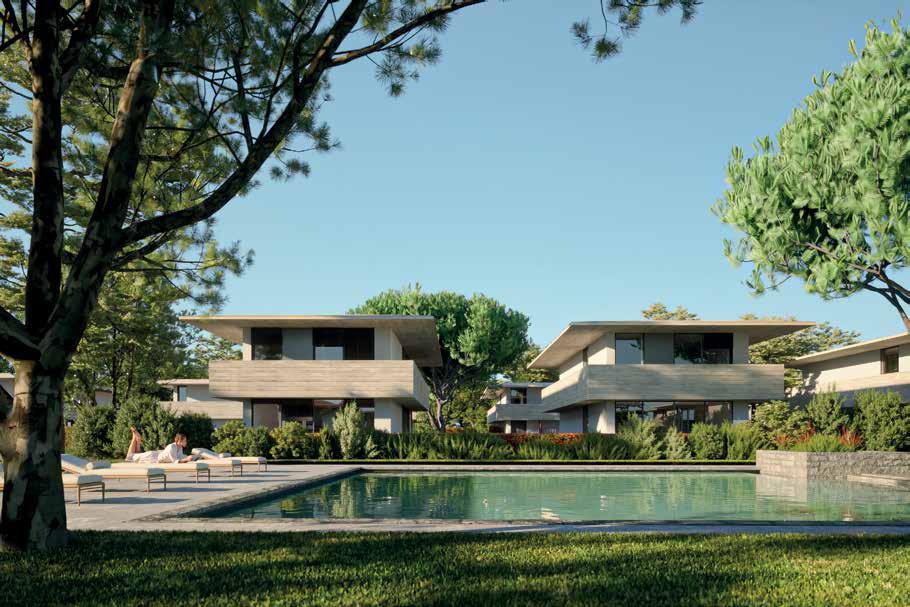
Fundador da Magazine Imobiliário Founder of Magazine Imobiliário Joaquim Pereira de Almeida
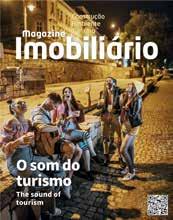
Directora Director
Carla Celestino
Sede de Redacção / Editor Rua Paulo Reis Gil nº 39, 3º Esq. 2745-195 Queluz
Colaboradora Permanente Permanent Contributor Elisabete Soares
Colaboradora
Contributor Madalena Guinote Ramos
Fotografia Photography Anabela Loureiro
Tradução Translation
Chris Graeme
Grafismo Graphics Luís Silva
Contabilidade Accounting Nasceconta
Periocidade Frequency Bimestral
Tiragem Number printed 3.000 exemplares
Impressão Printing Jorge Fernandes, Lda. Rua Qta. de Marcarenhas, 2820 Charneca da Caparica
Depósito Legal Legal Deposit 363718/13
SSN – 2183-0517
ERC – 126397
Estatuto editorial disponível em: Editorial policy available at: www.magazineimobiliario.com


Dizem que o silêncio é de ouro. Será? Ninguém fica indiferente à simpatia hospitaleira dos portugueses que, de sorriso de orelha a orelha, dizem: “Boas férias!”; mas também ninguém fica indiferente ao ruído de fundo dos tuk-tuks mal estacionados.
Então, qual deve ser a ressonância do turismo nas cidades?
It is said that silence is golden. Can that be achieved? No one can be indifferent to the kind hospitality of the Portuguese who with a smile from ear to ear, say: “Happy Holidays!” but no one is indifferent to the background noise of the badly parked tuktuks. So, what should the resonance from tourism be in cities?
A primeira vez que pensei no som do turismo estava no Cairo e a meu lado estava uma professora reformada do primeiro ciclo, da região do Algarve, que exclamava: “Tanto barulho e tão alto, são as buzinadelas dos taxistas, é o regatear do mercado, são os altifalantes com as orações…” Ela não parecia muito satisfeita, já da minha parte eram precisamente esses sons o que mais me encantava naquela cidade. Muito mais do que as cores ou os aromas.

O que dizer de Cuba com música dia e noite, de Macau com o frenesim do jogo, da festa da cerveja de Munique ou do jazz nos bares de Nova Orleães. Todas as cidades têm o seu som, é único, é quase uma impressão digital sonora.
Claro, o turismo português também tem a sua própria melodia. Quando vamos de férias ou em trabalho além-fronteiras, quando estamos longe da Pátria, é quando a nossa alma mais se recorda dessa sonoridade. Quem nunca se emocionou a ouvir num país estrangeiro alguém dizer algo tão simples e em bom português: “Deseja um café?” e se a isso acrescentar a palavra “pastel de nata?”, então derretemos, mesmo para quem não aprecia café ou pastel de nata.
Por cá, os nossos sons cruzam-se com os deles, dos diferentes linguajares dos turistas ingleses, alemães, franceses, espanhóis, nór-
dicos, brasileiros…, à procura de momentos genuínos, de experiências locais, de uma boa noite de fados ou de apenas esticar ao sol à beira-mar e escutar as gaivotas a sobrevoar as suas cabeças.
Numa era em que a fronteira entre trabalho e lazer se esbate, a definição de excursionista ou turista poderá adquirir, no futuro, novos contornos, já que a tendência é para se criar espaços dentro do destino turístico em que os visitantes se diluem com os residentes e passam mais tempo nesse local. Com isso mitigam-se todos os impactes turísticos, ambientais, económicos, sociais, culturais, inclusivamente sonoros.
Cada cidade tem os seus sons que são amplificados com a chegada de turistas de diferentes geografias. Uns são bons, vão dos ouvidos ao coração, outros nem tanto, preferimos fazer “orelhas moucas”. A isto se chama turismo de ressonância.
Verdade seja dita, só damos valor ao que temos quando o perdemos. E o assombro do silêncio foi o que mais me chocou durante o confinamento no âmbito da pandemia de Covid-19. Onde estavam as esplanadas cheias e as pessoas a trocar dois dedos de conversa? Onde estavam os turistas a pedir direcções?
Onde estavam os aviões a rasgar os céus?
Nessa altura li um artigo publicado por dois investigadores - Daniel Paiva, do Centro de Estudos Geográficos da Universidade de Lisboa, e Iñigo Sánchez, do Instituto de Ciencias del Patrimonio (Incipit - CSIC) de Santiago de Compostela (Espanha) -, que dizia respeito precisamente à ressonância do turismo. Ambos pegaram no caso concreto de Lisboa e, a partir da sua análise, concluíram que na capital portuguesa, não só o turismo “ressoa em todos os cantos”, como “é um meio privilegiado para compreender os múltiplos
impactos que tem na paisagem lisboeta não só em termos da ecologia acústica, mas também a nível financeiro, comercial, habitacional, social, político, e urbanístico.”
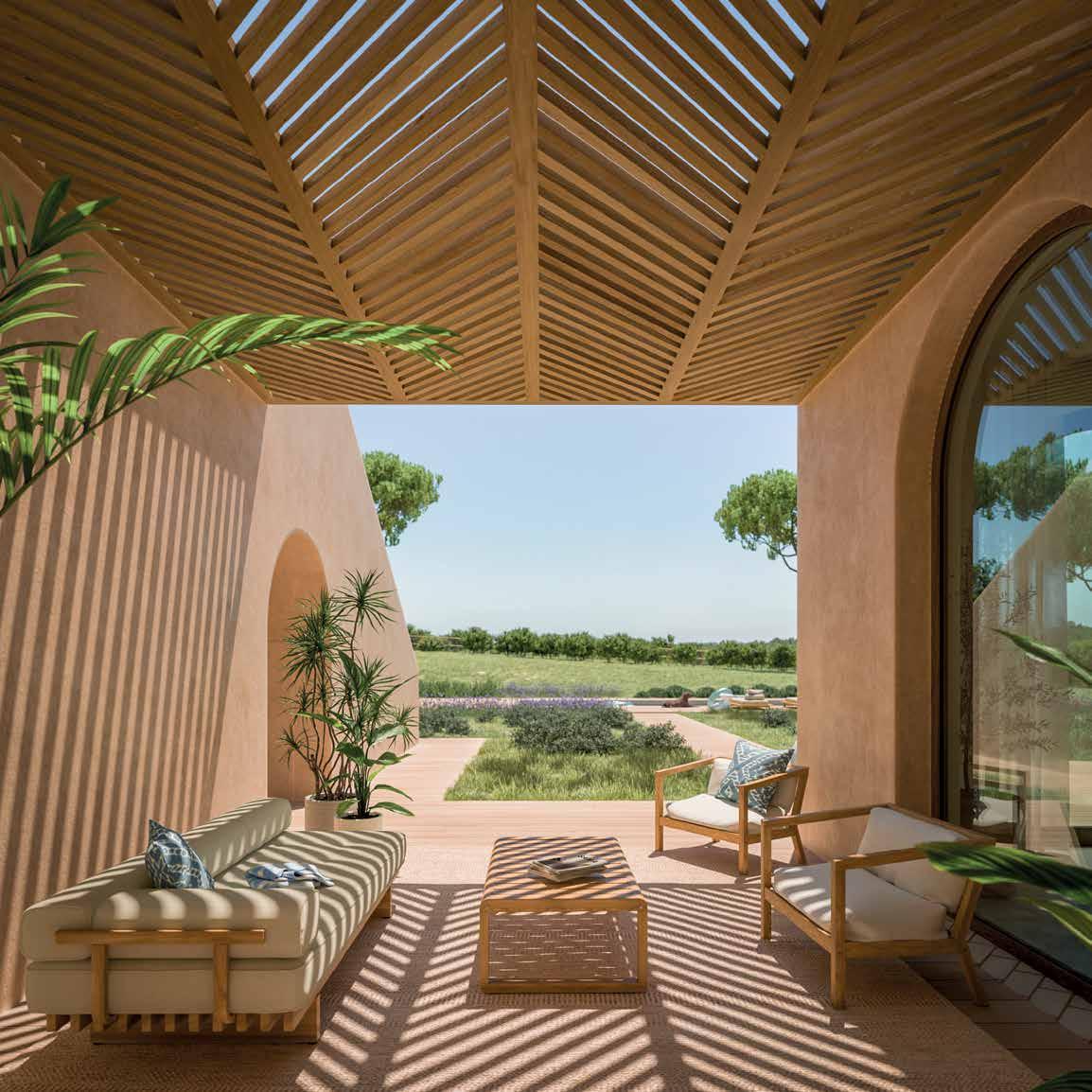
Na sua opinião, e frisamos que esta é, na verdade, uma realidade transversal a todas as cidades receptoras de turismo, “é importante não apenas escutar, mas também atender à multiplicidade de seres que ouvem e produzem sonoridades no processo de turistificação da cidade.”
Temperatura

Aumentar a pressão sobre os bancos centrais nacionais
O mês de Junho ficou marcado por uma acção concertada europeia com o intuito de pressionar os bancos centrais nacionais de cada país da União Europeia a promover medidas fortes e eficazes de apoio aos objectivos climáticos. Em Portugal a iniciativa foi direccionada ao Banco de Portugal.
O objectivo que uniu os activistas foi sensibilizar o Conselho de Administração do Banco Central Europeu a aplicar taxas de juro reduzidas para a renovação em prol da eficiência energética, pois acreditam que esta medida garantirá a disponibilidade de empréstimos acessíveis para renovação em toda a Europa, cumprir os objectivos climáticos e proteger as famílias europeias quer de condições meteorológicas extremas como ondas de calor quer da volatilidade e aumento dos preços da energia.
June was marked by a concerted European climate activists’ campaign to pressure the national central banks of each EU Member State to enact strong and effective measures to support climate action goals. In Portugal, this campaign was directed at the Bank of Portugal.
The goal which unites all the activists was to pressure the Administrative Board of the European Central Bank to apply reduced interest rates on energy efficient property renovation and they believe that this measure will guarantee that affordable loans will be made available for renovations all over Europe, meet climate targets, and protect European families against both extreme weather conditions such as heatwaves and volatility as a result of increased energy prices.


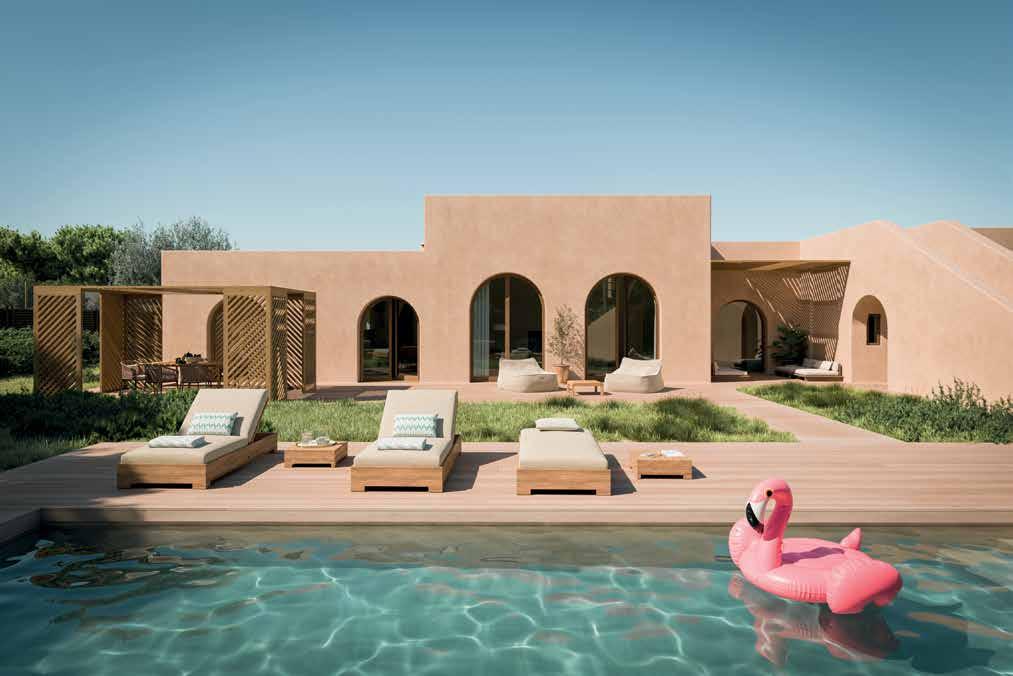




mapeá-las, permitindo que elas desvendem as diversas facetas deste fenómeno, entrem em diálogo e, com alguma sorte, descubram uma possível co-habitação.”
Mas será esta “co-habitação” possível nos destinos massificados?
A análise dos investigadores Daniel e Iñigo traz, por outro lado, a debate uma questão pertinente e urgente: os sons de ruptura. Se antes de Covid-19 o turismo estava ao rubro, agora com o fim da pandemia e a liberdade de mobilidade, o turismo está novamente a recuperar e com isso a regressar a um conflito sonoro entre residentes, trabalhadores e turistas, com efeitos nefastos para todos os lados.
Quantas vezes, num jardim da cidade, as vozes dos turistas entusiasmados ou a música dos tuk-tuk se sobrepuseram ao chilrear das andorinhas ou dos nossos próprios pensamentos. Já para não falar da vida nocturna, cuja frequência colide entre quem apenas quer beber um copo e os habitantes desses locais que apenas querem descansar, sem barulho.
Dizem que no futuro o turismo nas cidades poderá passar pelas viagens virtuais e com isso minimizar os impactes do ruído (entre muitos outros). Será? Não me parece que consiga substituir a experiência real das curvas sinuosas do eléctrico 28 na Graça, apre -
ciar uma posta à Mirandesa, fazer mergulho em S. Miguel ou sentir o aroma real das flores e frutas da Madeira.
Mas seria bom, nesta fase de recuperação que o turismo português agora reinicia, trabalhar melhor a sonoridade turística, seja de Lisboa, Porto, Faro… os nossos ouvidos agradecem!
The first time I thought about the sound from tourism was in Cairo when there was a retired primary school teacher from the Algarve region stood next to me who exclaimed: “So much loud noise; the taxi drivers honking their horns, and the haggling of the markets, and the call to prayer from the loudspeakers.” She did not seem to be terribly happy. As for me, it was precisely these sounds that I found most charming in that city. A lot more than the colours and smells.
The same goes for Cuba with its music day and night, Macau with the frenetic frenzy of the casinos, Munich’s Oktoberfest with all the beer, or the jazz in the bars in New Orleans. Every city has its sound, it is unique and almost seems like a digital soundtrack.
Of course, Portuguese tourism also has its own melody. When going on holiday or working overseas, when we are far from home, and when our soul remembers this sound. And who hasn’t got all emotional in a foreign country hearing someone say something quite simple in good Portuguese? “Would

Short or long-term investments?
O último Barómetro de Práticas de Pagamento divulgado pela Crédito y Caución detectou uma tendência emergente entre as empresas da Europa Ocidental que, de forma generalizada, estão a atrasar o arranque dos seus planos de investimento para conservar liquidez e fazerem face ao difícil quadro económico actual.
A decisão de atrasar ou parar os investimentos, além de ser um sinal de maiores dificuldades financeiras, também representa uma ameaça significativa para o crescimento económico das empresas e sectores. Mas não deveriam as empresas prestar mais atenção a âmbitos nos quais os investimentos a longo prazo são cruciais, como a transição para as energias limpas ou a formação de mão-de-obra altamente qualificada?
The most recent Payment Practices Barometer released by credit insurer Crédito y Caución detected an emerging trend among Western European countries that in a general form is delaying the launch of their investment plans to preserve liquidity and to deal with the current unfavourable economic scenario.
The decision to delay or stall investments is, according to the insurer, apart from being a sign of greater financial difficulties, also represents a significant threat to the economic growth of companies and sectors. But shouldn’t companies pay more attention to areas in which longterm investments are crucial such as transition to clean energies or the or training highly qualified workforce?
Cada cidade tem os seus sons que
amplificados com a chegada de turistas de diferentes geografias. A isto se chama turismo de ressonância. Each city has its sounds which are amplified with the arrival of tourists from different geographies. This is called the noise of tourism.”

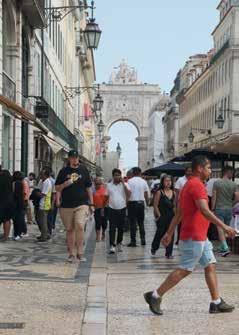
you like a coffee?” and if to this the word ‘pastel de nata’ is added, then our hearts melt, even for those who don’t appreciate coffee or a Portuguese custard tart. Here, our sounds mingle with theirs, the different parlance of the English, German, French, Spanish, Scandinavian, and Brazilians..., looking for authentic local experiences, a good night of fado or even stretched out in the sun by the sea and listening to the seagulls flying above our heads.
In an era when the boundary between work and leisure is blurred, the definition of a daytripper, tourist or visitor could, in future, acquire new connotations, since the trend is to create new spaces within a tourisms destination in which the visitors blend in with the local residents and spend more time in the place. This mitigates all the tourist, environmental, economic, social, cultural impacts, including noise.
Each city has its sounds which are amplified with the arrival of tourists from different geographies. Some are good, we hear them and adopt them in our hearts, others less so, we prefer to shut them out. This is called the noise of tourism.
If the truth be told, we only value something
when we’ve lost it. And it was the haunting silence that shocked me the most during lockdown because of the Covid-19 pandemic Where were the packed esplanades full of people chatting? Where were the tourists asking for directions? Where were the aircraft tearing through the skies?
At that time, I read an article published by two researchers - Daniel Paiva from the Centre of Geographic Studies, and Iñigo Sánches from the Institute of Patrimonial Sciences (Incipit - CSIC) at Santiago de Compostela (Spain) -, that was specifically about the resonance of tourism.
Both chose Lisbon as a specific case study and from their research concluded that it was not just tourism that “sounded out in every corner” of the Portuguese capital, but it is also a perfect milieu to understand the many impacts that the Lisbon landscape has, not just in terms of acoustic ecology, but also at a financial, commercial, housing, social, political, and urban level.”
In their opinion - and we emphasise that this is a reality that cuts across all cities that attract tourists - “it is important to not only listen but also to pay attention to the multiplicity of people that hear and make sounds in the process of the touristification of the city.” Daniel and Iñigo argue that it is important to compile these sounds and chart them, ena -
são
bling them to shed light on the various facets of this phenomena, have a dialogue, and with a bit of luck, discover a way of possibly coexisting.”
But is this ‘co-habitation’ possible in destinations with mass tourism?
The research from the researchers Daniel and Iñigo on the other hand spurred a debate on an important and urgent issue: the sounds of rupture.
If before Covid-19 tourism was at full steam, now with the end of the pandemic and freedom of movement, tourism is once again recovering, and with it the return of a clashing sound between residents, employees, and tourists, with detrimental effects for all sides. So many times, in a city garden the shrill sound of the swallows or our own thoughts
get drowned out by enthusiastic tourists, music or the sound of the tuk-tuks. That’s before even talking about nightlife whose frequency clashes between those who want to have a drink and the residents in these places that simply want to relax without all the noise. They say that in future tourism could evolve into virtual visits and thereby minimise the impacts of noise (among many others. Is that likely? I don’t think we’ll succeed in replacing the authentic experience of taking the Nº28 tram at Graça along those winding streets to enjoy a thick Mirandese steak, go diving in São Miguel, or smell the scent of the flowers and fruits of Madeira.
But it would be nice, in this phase of recovery for Portuguese tourism, to have a clean slate, to work towards improving the sound of tourism whether in Lisbon, Porto, or Faro ... Our ears would be grateful!



Na capital portuguesa o turismo “ressoa em todos os cantos”. Tourism “sounded out in every corner” of the Portuguese capital.”
 Grupo Vila Galé
Vila Galé Group
Grupo Vila Galé
Vila Galé Group

Gonçalo Rebelo de Almeida, administrador do Grupo Vila Galé, fala sobre o crescimento, posicionamento e diferenciação de uma marca hoteleira de prestígio que se encontra a celebrar 35 anos. Com “muitos momentos marcantes” e boas perspectivas para o Verão de 2023, revela-se imparável com novas unidades a nível nacional e internacional.
Gonçalo Rebelo de Almeida, CEO of the Vila Galé Group talks about the growth, positioning and differentiation of a prestige hotel brand that is celebrating its 35th anniversary. With “many milestone moments’” and a good outlook for the summer of 2023, its full steam ahead with new hotels both nationally and internationally.

A atestar pelas novas aberturas de hotéis do Grupo Vila Galé - Vila Galé Monte do Vilar, Vila Galé Nep Kids, Vila Galé Collection São Miguel e Vila Galé Collection Tomar - podemos dizer que o mercado hoteleiro está de “boa saúde e aconselha-se”?
Sim, nos últimos meses abrimos mais três hotéis em Portugal: o Vila Galé Collection Monte do Vilar, Beja, em Abril; o Vila Galé Nep Kids, também em Beja, e o Vila Galé São Miguel, em Ponta Delgada, em Junho. Em Julho, abriremos o quarto, o Vila Galé Collection Tomar. São projectos que já tínhamos em curso e que concluímos nos prazos previstos, que acabam também por confirmar o dinamismo do sector do Turismo e o papel fundamental que continua a desempenhar na economia portuguesa. De facto, depois das graves quebras que toda a hotelaria registou durante a pandemia, no caso português, a recuperação foi até mais rápida do que se previa e os resultados têm sido positivos, apesar de alguma incerteza que existe devido à conjuntura.
O que vos levou a abrir estas unidades, qual o montante investido e quais as vossas expectativas para estas unidades para o Verão de 2023?
São unidades bastante diferenciadas, mas que vêm completar a oferta e a cobertura que temos em Portugal, onde contamos agora com 31 hotéis. Com a abertura do Vila Galé Collection São Miguel, ao qual dedicámos 12 milhões de euros, chegámos aos Açores, que já era uma ambição antiga. E passámos a ter marca Vila Galé em
todas as grandes regiões de turismo do país. Trata-se de uma unidade com 92 quartos, no centro de Ponta Delgada, instalada no edifício onde antigamente funcionavam o convento e hospital de São Francisco, que reabilitámos em parceria com a Santa Casa da Misericórdia. Já o Vila Galé Nep Kids, onde investimos outros 12 milhões de euros, tem um conceito totalmente inovador, uma vez que os adultos só podem entrar se acompanhados por crianças. Esta unidade foi pensada de raiz para o público infantil e tem várias piscinas exteriores com escorregas, carrossel, slide, trampolins, sala de cinema, parede de escalada, pista de condução, polidesportivo, campos de beach ténis e de padel, ilha do tesouro com lago para andar de gaivota, parque infantil, espaço de jogos com snooker, mesa de ar, matraquilhos e simuladores, e vários apontamentos museológicos, por exemplo. Fica no Clube de Campo Vila Galé onde também abrimos recentemente o Vila Galé Collection Monte do Vilar, um agroturismo de charme vocacionado para maiores de 16 anos, com 12 quartos, que representou um investimento de quatro milhões de euros. Desta forma, na mesma propriedade, a herdade com 1.620 hectares, onde produzimos os vinhos e azeites Santa Vitória, ficámos com três unidades e três conceitos diferentes, que se complementam entre si, permitindo captar novos segmentos e mercados. Aqui já tínhamos o hotel rural Vila Galé Alentejo Vineyards & Olive (ex-Vila Galé Clube de Campo), que está agora mais vocacionado para experiências diferenciadoras de Enoturismo, Olivoturismo e Turismo de Natureza
A 1 de Julho abre o Vila Galé Collection Tomar, outro projecto de requalificação de um imóvel histórico, neste caso o antigo Convento de Santa Iria e o ex-colégio feminino. O investimento previsto é de 14 milhões de euros. Até agora, temos registado boa procura e temos perspectivas positivas para o Verão. As novas unidades despertam sempre bastante interesse e curiosidade.
Na sua opinião, como perspectiva que vá decorrer no Verão de 2023?
A nossa expectativa é que a procura e a performance no Verão fiquem em linha com o que tivemos no ano passado, que foi bom. Naturalmente que estamos atentos à evolução da conjuntura económica, em particular ao comportamento da inflação e das taxas de juro, que podem ter impacto no rendimento disponível das famílias. Mas, até agora, não notámos redução na procura face ao que seria expectável.
A vossa aposta internacional continua a passar pelo Brasil, com a abertura, em 2024, do Vila Galé CollectionSunset Cumbuco. Como está a decorrer a vossa actividade no mercado hoteleiro brasileiro e o que esperam desta nova unidade?
Sim, é um país onde ainda vemos muitas oportunidades e onde estamos constantemente a analisar possibilidades de investimento. O Vila Galé Sunset Cumbuco será o primeiro hotel da sub-marca Collection no Brasil e pretende complementar a oferta que já temos no Vila Galé Cum-

buco, que é um resort all inclusive. Com este novo projecto, com abertura prevista para o próximo ano, acreditamos que vamos conseguir atrair novos públicos e ter uma proposta de alojamento mais abrangente e completa. O Vila Galé Collection Sunset Cumbuco terá 124 quartos, piscina exterior para adultos, parque aquático para as crianças, um restaurante em frente à praia, Satsanga Spa &Wellness com piscina interior, salas de massagem e ginásio, campos desportivos e um centro náutico. Estamos também a desenvolver outra unidade Collection em Ouro Preto, no estado de Minas Gerais. Resultará da requalificação do antigo colégio Dom Bosco, pondo em prática o que tem sido um dos aspectos diferenciadores da Vila Galé: a requalificação de património histórico que estava degradado, dando-lhe uma nova vida. O futuro Vila Galé Collection Ouro Preto contará com 182 quartos na primeira etapa e 46 na segunda etapa, dois restaurantes, dois bares, sete salas de convenções, um auditório, capela, biblioteca, sala de jogos, Satsanga Wellness & Spa com piscina interior aquecida e clube infantil NEP com parque aquático, num investimento de R$ 80 milhões, que também deverá estar concluído no próximo ano.
Outra das nossas apostas tem sido a gastronomia e o intercâmbio cultural, por exemplo, com o lançamento recente da Cervejaria Portuguesa, cujo menu inclui pratos e petiscos lusos como polvo à lagareiro, arroz de marisco, bife à Marrare ou bitoque.
Tem havido também notícias sobre a vossa entrada em Cuba. Finalmente foi possível concretizar um sonho antigo?
Há já algum tempo que estávamos a estudar esse mercado e foi possível concretizar agora esse projecto. Em parceria com a Gaviota, empresa pública de turismo cubana, vamos administrar o Vila Galé Cayo Paredón, que será um resort all inclusive em Caio Paredón, a 25 minutos do aeroporto Jardines del Rey, em Cayo Coco. Deverá abrir em Outubro de 2023. Estamos também a desenvolver um projecto em Havana.
Em 2023 o Grupo Vila Galé celebra 35 anos. Como foram todos estes anos e o que espera dos próximos 35?
Foram 35 anos de um crescimento gradual e ponderado, sem dar passos maiores que as pernas, e com muitos momentos marcantes, como a entrada no Brasil, em 2001, ou o lançamento das marcas de vinhos e azeites Santa Vitória, no Alentejo, em 2002, e Val Moreira, no Douro, em 2018. Em 2013, a abertura do primeiro hotel de cinco estrelas, o Vila Galé Collection Palácio dos Arcos, em Paço de Arcos, foi outro marco. Ao longo destas três décadas e meia, temos vindo também a alargar o nosso portefólio de marcas, por exemplo, com as pizzarias Massa Fina, os Satsanga Spa &Wellness ou o Clube Nep, para as crianças.
Neste percurso temos ainda reforçado o foco em opções estratégicas como o investimento no interior do país, em destinos menos óbvios e com menores fluxos turísticos, para puxar por essas regiões, mas também para estimular o aparecimento de novos destinos, únicos e autênticos. Foi isso que fizemos em Manteigas, com o Vila Galé Serra da Estrela, em Alter do Chão ou em Elvas. Ou a aposta em hotéis temáticos, que permitem criar experiências únicas aos clientes, através de uma ligação à história do local e à cultura. Disso mesmo são exemplos o Vila Galé Porto Ribeira, dedicado à pintura, o Vila Galé Coimbra, que tem com tema a dança, o Vila Galé Collection Palácio dos Arcos, o hotel da poesia ou o Vila Galé Porto, associado ao cinema. Outro dos nossos elementos distintivos, como já referido, é a reconversão de edifícios históricos em hotéis, dando-lhes novas utilizações e gerando emprego. É isso que estamos a fazer em Tomar e que fizemos em Ponta Delgada, mas também em Braga, no Vila Galé Collection Braga (um antigo hospital), em Elvas (ex-Convento de São Paulo), na Coudelaria de Alter do Chão, ou no Vila Galé Albacora, um antigo arraial de pesca do atum. Nos próximos anos, continuaremos a ter es-
tas estratégias orientadoras, mantendo ainda os restantes elementos que posicionam e diferenciam a marca: foco no turismo para famílias, qualidade e diversidade gastronómica, formação, valorização e motivação das equipas e proximidade e orientação para o cliente.
A sustentabilidade é outros dos pontos que ocupa um papel de relevo na Vila Galé, já que procuramos ter uma operação social e ambientalmente equilibrada. A par disso, é de destacar a inovação e a transformação digital, graças à introdução de políticas paper free e plastic free nos hotéis e a ferramentas como a plataforma My Vila Galé, disponível online, que permite fazer o check in e check out, consultar as cartas dos restaurantes, bares e spa de todos os hotéis e gerir as reservas.
Judging by the latest Vila Galé Group hotel inaugurations - Vila Galé Monte do Vilar, Vila Galé Nep Kids, Vila Galé Collection São Miguel and Vila Galé Collection Tomar - could it be said that the hotel market is in “good shape?” Yes!In recent months we’ve opened three more hotels in Portugal: Vila Galé Collection Monte do Vilar, Beja, in April; the Vila Galé Nep Kids, also in Beja, and the Vila Galé São Miguel, in Ponta Delgada, in June. In July we opened the fourth, the Vila Galé Collection Tomar. These are projects that we already had underway and will be completed within the set periods which also confirm the buoyancy of the tourism sector and the key role that it continues to play in the Portuguese economy.
In fact, after the serious falls that the entire hotel sector suffered during the pandemic, in the Por-
tuguese case the bounce back was even faster than had been predicted, with positive results despite some uncertainty that exists due to the economic backdrop.

What led you to open these hotels, how much was invested and what are your expectations for these hotels for the summer of 2023?
These hotels are all quite different but will complete the offer and coverage that we have in Portugal where we currently have 31 hotels. With the opening of the Vila Galé Collection São Miguel,for which we’ve earmarked 12 million euros, we’ve achieved a long-held ambition of opening a hotel in the Azores. And now we have the Vila Galé brand in all the important tourism regions in Portugal. This is a 92room hotel in the centre of Ponta Delgada in a building which was once a convent and the hospital of São Francisco which we’ve refurbished in partnership with the Santa Casa da Misericórdia.
Then the Vila Galé Nep Kids in which we’ve invested some 12 million euros has a completely innovative concept since adults can only stay with their children. This hotel concept was designed from scratch for kids and has several outdoor pools with slides, a carousel, trampolines, cinema room, climbing wall, karting track, multi-sports pitch, beach tennis and padel courts, treasure island with lake with seagull boat rides, children’s playgrounds, games room with snooker, air hockey table, table soccer and simulators, and several museum displays, for example. It is in the Clube de Campo Vila Galé where we also recently opened the Vila Galé Collection Monte do Vilar, a boutique agrotourism hotel for the over 16s, with 12 rooms and involved a four-million-euro investment. This means that there are three hotels with three different concepts on the same 1,620 hectares property where we produce Santa Vitória wines and olive oils, which complement each other and attract new segments of the market. Here we already had the rural hotel Vila Galé Alentejo (ex-Vila Galé Clube de Campo) which is now more orientated towards different experiences like wine, olive oil and nature tourism. The Vila Galé Collection Tomar will open on July 1. This is another historic building refurbishment project, in this case the former Santa Iria Convent and a former girls’ college. The slated investment is 14 million euros. To date we have seen good demand and we have positive expectations for the summer.
The new hotels have fired a fair bit of interest and curiosity.
In your opinion how do you see the summer of 2023?
Our expectation is that demand and summer performance will be in line with what we had last year, which was a good year. Naturally, we are aware of the economic backdrop, in particular inflation and interest rates, that could have an impact on family disposable income. But to date we have not noticed a reduction in the demand we would usually expect.
Your international strategy continues to involve Brazil with the opening in 2024 of the Vila Galé Collection Sunset Cumbuco. How is your activity in the Brazilian hotel market going and what do you expect from this new hotel?

Yes, Brazil is a country where we see a lot of opportunities and where we are constantly analysing investment possibilities. The Vila Galé Sunset Cumbuco will be the first hotel in Brazil of the sub-brand Collection and aims to complement the offer that we have at the Vila Galé Cumbuco which is an all-inclusive resort. With this new project slated to open next year, we believe that we’ll be able to attract a new public and have a broader and more complete accommodation offer. The Vila Galé Collection Sunset Cumbuco will have 124 rooms, outdoor pool for adults, water park for kids, a beach front restaurant, Satsanga Spa & Wellness with indoor pool, massage room and gym, sports fields, and a nautical
centre. We are also developing another Collection hotel in Ouro Preto in the State of Minas Gerais. It will result from the refurbishment of the former Dom Bosco College, putting into practice what has been one of the main differentiating aspects of Vila Galé: the refurbishment of the historic heritage that was dilapidated, giving it a new lease of life. The future Vila Galé Collection Ouro Preto which should be completed next year, will have 182 rooms in the first stage and 46 in the second stage, two restaurants, two bars, seven convention rooms, an auditorium, chapel, library, games room, Satsanga Wellness & Spa with a heated indoor pool and NEP kids club with a water park, in a total investment of R$80 million.
Another of our foci has been cuisine and cultural exchanges, for example with the recent launch of the Cervejaria Portuguesa, whose menu includes Portuguese dishes and snacks like octopus à lagareiro, seafood rice, steak à Marrare and steak with fried egg.
Your entering the Cuban market has also been in the news. Were you finally able to realise a long-held dream?
We had been studying this market for some time and now it has been possible to achieve this project. In partnership with Gaivota, the Cuban public tourism company, we will manage the Vila Galé Cayo Paredón which will be an all-inclusive resort in Caio Paredón, 25 minutes from Jardines del Rey airport in Cayo Coco. It is slated to open in October 2023. We are also developing a project in Havana.
In 2023 the Vila Galé Group celebrates 35 years. How have all these years been and what do you expect for the next 35 years?
They have been 35 years of gradual and projected growth in a sustainable way, with many landmark moments such as our entry into Brazil in 2001, or the launch of the Santa Vitória brand wines and olive oils in the Alentejo in 2002 and Val Moreira in the Douro in 2018. The opening of the Vila Galé Collection Palácio dos Arcos in Paço de Arcos near Lisbon in 2013 was another milestone. Over these three decades and a half, we have also expanded our brands portfolio with pizzarias Massa Fina, Satsanga Spa & Wellness and Clube Nep for kids.
We’ve also reinforced our focus on strategic options like investing in the interior of the country in less obvious destinations with less tourist flows to encourage tourism to these regions but also to stimulate the appearance of new, unique, and authentic destinations. This was the case in Manteigas, with the Vila Galé Serra da Estrela, in Alter do Chão and in Elvas. Then we went in for theme hotels that have enabled us to create unique experiences for clients by creating a historic link with the history and culture of these places. Examples of this are the Vila Galé Porto Ribeira, dedicated to painting, the Vila Galé Coimbra, where the theme is dance, the Vila Galé Collection Palácio dos Arcos, whose theme is poetry, and the Vila Galé Porto, which is associated with cinema. Another of our distinct features, as has been mentioned, is reconverting historic buildings into hotels, giving them fresh uses, and creating jobs. This is what we’re doing in Tomar and what we’ve done in Ponta Delgada, but also in Braga at the Vila Galé Collection Braga (a former hospital), in Elvas (exConvent of São Paulo), at the Coudelaria de Alter do Chão, or at Vila Galé Albacora, a former tuna fishermen’s community.
In the next few years, we will continue to have these guiding strategies, also maintaining the other aspects that position and differentiate the brand: the focus on tourism for families, quality and diversity of cuisine, training, valuing and motivating teams and being guest centric. Sustainability is another of the points that occupies a key role at Vila Galé in that we seek to have a balanced environmental and social operation. Equally, I would highlight innovation and digital transformation, thanks to the introduction of paper and plastic free policies in the hotels and features such as the on-line availability platform My Vila Galé which permits guests to check-in and check-out, consult restaurant, bar and spa menus at all hotels and manage reservations.
É possível viver a dois passos de Lisboa com o conforto reservado a quem está de férias. Ora veja!

Piscina / Ginásio / Sala Multiusos / Lobby decorado / Zonas verdes e de lazer / Cozinhas equipadas / Interiores amplos e agradáveis varandas / Estacionamento privativo / Excelentes acessos /
Sustentabilidade e eficiência energética
T1 a T4, em condomínio fechado, desde €260 000.

Investimento
Hotel groups pour into Porto
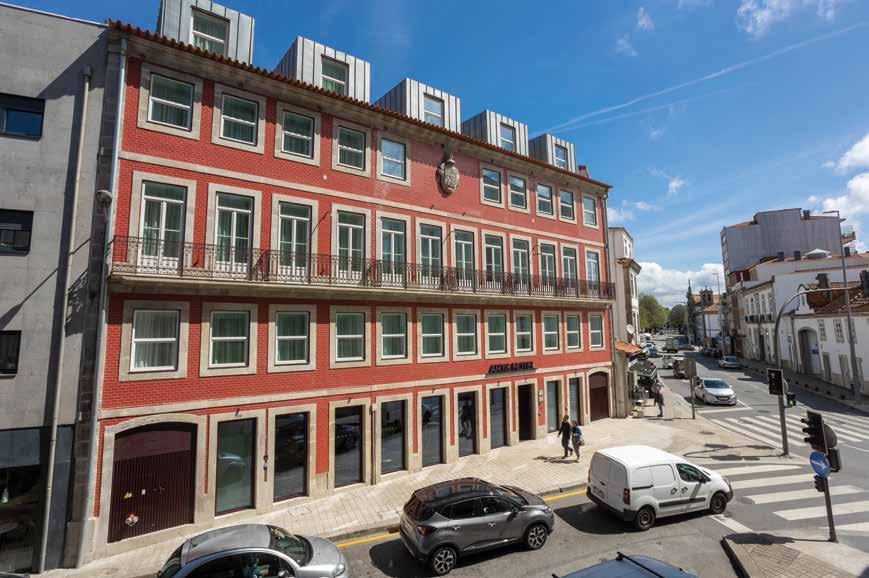
Os turistas estão de regresso ao Porto e esta situação é visível na ocupação hoteleira que disparou sobretudo depois da semana da Páscoa. Também nas últimas semanas assistimos à abertura de várias unidades hoteleiras, de média e grande dimensão, como é o caso do novo hotel gerida pela Sonae Capital, o The Editory Garden Porto Hotel, com 46 quartos. Contudo, o destaque vai para o Renaissance Porto Lapa Hotel, promovido pelo grupo canadiano Mercan Properties, que se situa nas imediações da Igreja da Lapa e dispõe de 163 quartos e suites. Poucos dias antes o mesmo grupo tinha inaugurado o Arts Hotel Porto, Tapestry Collection by Hilton, localizado no centro do Porto, próximo do Jardim de São Lázaro, que apresenta 53 quartos. No próximo mês de Setembro a cidade vai ter a abertura de um novo hotel Vincci – a terceira unidade na região - localizado no coração da cidade, a Rua do Bonjardim. O promotor do “imponente hotel em construção, com quatro estrelas e 104 quartos” é a Dmanán, grupo imobiliário com sede em Lugo, Galiza, que chegou há poucos anos à Invicta, mas está a desenvolver um conjunto significativo de projectos residenciais e hoteleiros no Porto e em Lisboa.
No caso da Invicta, o grupo galego comprou o conhecido Palácio de Belomonte, localizado também no centro da cidade, que está a ser “remodelado e transformado num emblemático hotel de cinco estrelas, com 50 quartos”, refere. A obra, em início de construção, tem
prevista a conclusão em 2025, mas a escolha da cadeia já é conhecida. Trata-se da cadeia Coolrooms, com várias unidades em Espanha, que resultam da transformação de edifícios emblemáticos em hotéis de luxo.

Para os responsáveis da Dmanan a aposta na hotelaria nas duas maiores cidades portuguesas deve-se à convicção de “que o turismo urbano está já a atingir valores superiores à pré-pandemia”.
Esta é também a convicção que João Madeira, responsável da Sonae Capital. Considera que neste mercado “há uma grande oportunidade”, contudo “precisamos de mais oferta”, referiu o responsável num evento público recente.
A zona dos Aliados, onde já se instalaram marcas hoteleiras premium e lojas de produtos de luxo, “é um destino natural” para novos investimentos hoteleiros, refere o estudo “Porto is what WE make it”, apresentado recentemente pela Cushman & Wakefield. A consultora destaca que nos próximos três anos, o Porto irá contar com mais cinco hotéis, num total de 460 quartos, com as unidades de cinco estrelas a representarem 48% desta nova oferta.
Em 2022, o concelho viu reforçada a sua capacidade de alojamento turístico com a abertura de mais 11 estabelecimentos hoteleiros.
Actualmente, tem 140 hotéis, que no conjunto dispõem de 9600 quartos. Significativo é que metade deste stock tem classificação de quatro estrelas e 22% de cinco estrelas.
A capacidade hoteleira do Porto está longe de estar esgotada e isso é visível nas aberturas recentes e nos novos cinco hotéis, a maioria deles de cinco estrelas, previstos para os próximos três anos. Hotel capacity in Porto is far from saturated and this has been evident from the recent inaugurations and the five new hotels, the majority five-star, slated to open over the next three years.
Tourists are returning to Porto and this situation is visible in hotel occupation which has shot up, particularly after Easter week. In recent weeks we’ve seen the opening of various mid-size and large hotel units as is the case with the new hotel managed by Sonae Capital, The Editory Garden Porto Hotel with 46 rooms. However, the spotlight is on the Renaissance Porto Lapa Hotel developed by the Canadian Mercan Properties which is in the vicinity of the Lapa Church and has 163 rooms and suites. A few days beforehand, the same group had inaugurated the Arts Hotel Porto, Tapestry Collection located in the centre of Porto and close to the Jardim de São Lázaro with 53 rooms.
In September, the city will see the opening of a new hotel Vincci - the third in the region - located in the heart of the city on Rua do Bonjardim. The developer of the “impressive 4-star, 104-room hotel under construction” is Dmanán, a real estate based in Lugo, Galicia which arrived in Porto a few years ago, but is developing a significant number of hotels in Porto and in Lisbon.
In the case of Porto, the Galician group bought the well-known Palácio de Belomon-
te also located in the city centre that is being “refurbished and turned into a flagship fivestar hotel with 50 rooms”, he says. The works, which are at an early construction phase, are slated for completion in 2025, but the choice of hotel chain is already known. The project is for Coolrooms which has various units in Spain which turns landmark hotels into luxury hotels.
For the directors of Dmanan, the hotel investment in two of the largest Portuguese cities is down to the belief that “city tourism is already reaching higher numbers than in the pre-pandemic period.”
This is also shared by João Madeira who heads Sonae Capital. He believes that in this market there is a “great opportunity” but said “more offer is needed,” at a recent public event.
The Aliados area, where several premium hotel groups and luxury product shops have set up, “is the natural destination” for new hotel investments states the study ‘Porto is what WE make it’ by Cushman & Wakefield.

The consultancy highlights that over the next three years Porto will have five more hotels, with a total of 460 rooms, with five-star units
representing 48% of this new offer. In 2022 the district reinforced its tourist accommodation capacity with the opening of 11 more hotel establishments. Currently it has 140 hotels which together have 9600 rooms. It is significant that that half of this stock has a four-star classification and 22% is five stars.
Os turistas estão de regresso ao Porto e esta situação é visível na ocupação hoteleira.
Tourists are returning to Porto and this situation is visible in hotel occupation which has shot up.”






Todos nós no mundo da hotelaria portuguesa conhecemos o icónico Hotel Ritz. Quando o Hotel Ritz foi construído, destacou-se pela sua elegância, sofisticação e peças de Arte. Desde os baixos-relevos de Almada Negreiros, às tapeçarias de Portalegre e cerâmicas de autor, foram várias as obras que perduraram no tempo. Independentemente do passar das décadas e desde o início à actualidade, a arte sempre fez parte integrante da arquitectura de interiores do Ritz.
Tenho como premissa e inspiração, de que consoante a tipologia de hotel que estamos a desenvolver, a arte é, sem dúvida, algo de que devemos tirar partido e que deve fazer parte integrante da imagem que se pretende alcançar.
Tomando como exemplo alguns dos hotéis em que tenho trabalhado recentemente, não tenho qualquer dúvida de que os mesmos ficaram mais “ricos”, dependendo das peças e artistas que escolhemos nos mesmos. Por exemplo, no Hotel Mercure no Porto, a parede central “forrada” com vários quadros
originais e fotografias de autor, transmitem uma imagem “forte” ligada ao local - cidade do Porto.
Com as mesmas aspirações, surgiu o Hotel Moxy Oriente, “ousado” e com um design contemporâneo, no qual a arte urbana teve um papel fundamental. Conceito dirigido à geração Millennium tornou-se um dos spots desta zona da cidade de Lisboa.

Os murais de grande escala e com cores vibrantes, como por exemplo, o do artista português Aka Corleone, e as várias peças artísticas ajudam a tornar este hotel único, através da criação de um ambiente jovem, dinâmico, atractivo e com uma grande riqueza cromática.
Hotel Renaissance Porto Lapa, inaugurado em Abril de 2023, também merece um notável destaque por conseguir uma simbiose perfeita entre os vários espaços e as peças de arte. Desde logo, a marca Renaissance de Marriott é uma marca em que a Arte tem um papel fundamental e faz parte integrante das guide lines da marca.
Foi fascinante poder escolher obras de arte originais de artistas internacionais e portugueses, com destaque para Pedrita Studio, Isabel Mello, uma peça única de Clemens Behr e duas instalações artísticas, entre outros, de Manuel Caldeira. Toda a curadoria de arte foi desenvolvida através da utilização de vários estilos e técnicas artísticas, nomeadamente a cerâmica, através de peças com um carácter contemporâneo, que permitem uma reinvenção desta arte tão portuguesa.
Sem dúvida que a arte desempenha um papel essencial, valorizando os edifícios e os espaços, despertando emoções e contribuindo para uma melhor experiência nos espaços.
All of us in the Portuguese hospitality world are familiar with the iconic Ritz Hotel. When the Ritz was built, it was renowned for its elegance, its sophistication, and its art. From the low reliefs by Almada Negreiros to the tapestries from Portalegre, it was art that endured and regardless of the passing decades, art remains an integral part of the Ritz’s interior architecture.
As a designer I take inspiration from the premise that whatever the type of hotel we are developing, art is undoubtedly something that should be an integral part of the desired image.

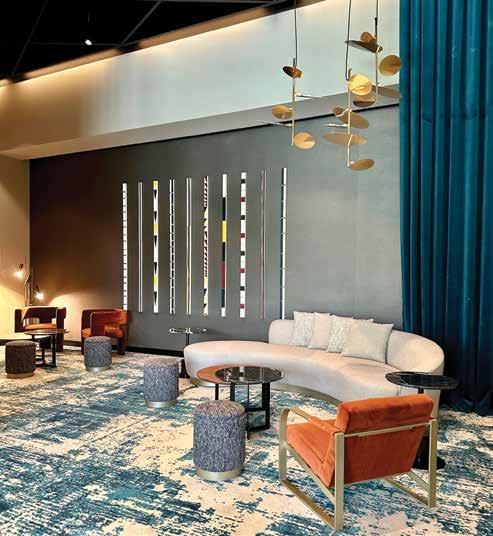
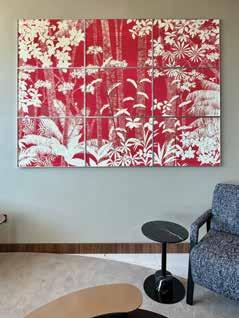
Taking as an example some of the hotels I

have recently worked on, I have no doubt that they became ‘richer’ through the pieces and artists we chose for them.
For instance, at the Mercure Hotel in Porto, the central wall includes various original paintings and photographs by renowned artists, conveying a strong link to its Porto context.
With the same aspirations, the Moxy Oriente Hotel has a bold and contemporary design, in which urban art plays a fundamental role. The interior design approach is focused more towards the millennial generation with large-

scale and vibrant murals, such as those by Portuguese artist AkaCorleone, each creating a unique and dynamic environment that has helped the hotel become one of the hotspots in this district of Lisbon.
The Renaissance Porto Lapa Hotel, inaugurated in April 2023, also deserves notable recognition for achieving a perfect symbiosis between the various spaces and art pieces.
The Renaissance brand of Marriott is a brand in which art plays a fundamental role and is an integral part of the brand’s guidelines. It was fascinating to be able to choose origi-
nal artworks by international and Portuguese artists including Pedrita Studio, Isabel Mello, a unique piece by Clemens Behr, and two art installations, among others, by Manuel Caldeira. The art curation is developed using various artistic styles and techniques, notably ceramics, and through featuring contemporary pieces that allow for a reinvention of this distinctly Portuguese art form.
Undoubtedly, art plays an essential role, enhancing buildings and spaces, evoking emotions, and contributing to a better experience in these spaces.
Está a preparar as suas férias?
Não resistimos em deixar-lhe três desafios: um para a sua carteira, outro para o seu impacto no planeta e outro para a sua saúde. Antes de partir, verifique a pressão dos pneus e, durante a viagem, limite a velocidade máxima, pois assim, pode poupar até 15% nos custos de combustível, e a sua carteira agradece.
Se está a planear alugar um veículo para as suas férias, por exemplo para passear pela Costa Vicentina, por que não aproveitar para experimentar um veículo eléctrico? A calma das férias pode ser o momento certo para entender o que muda quando utilizamos uma viatura eléctrica. O planeta agradece. Aproveite, e volte aos tempos de criança ao andar de bicicleta, provavelmente até tem uma na garagem. É só tirar o pó, e verificar a pressão dos pneus, e quem sabe, depois até experimenta aquela ciclovia nova perto de sua casa. A sua saúde agradece. Os desafios da ADENE não ocupam lugar. Quais destes vai levar na sua mala? Boas férias!

Are you gearing up for your holidays?
We can’t resist throwing down three challenges: one for your wallet, another for your impact on the planet, and a third for your health.
Before setting off, check your tyre pressure and during the journey limit your top speed since you can save up to 15% on fuel costs and your wallet will thank you.
If you are planning to rent a vehicle for your holidays, to tour the Costa Vicentina for example, why not try an electric vehicle? Your relaxing holidays could be the right time to learn what changes you can make by using an electric vehicle. And you’ll help the planet. Why not take a bike like you did as a kid. You’ve probably got one in the garage. It just needs dusting down and a tyre pressure check, and who knows, why not try out that new cycle path near your home. It’s more healthy for you.
These challenges from ADENE won’t take up any space. So which of these will you pack in your bags? Happy holidays!

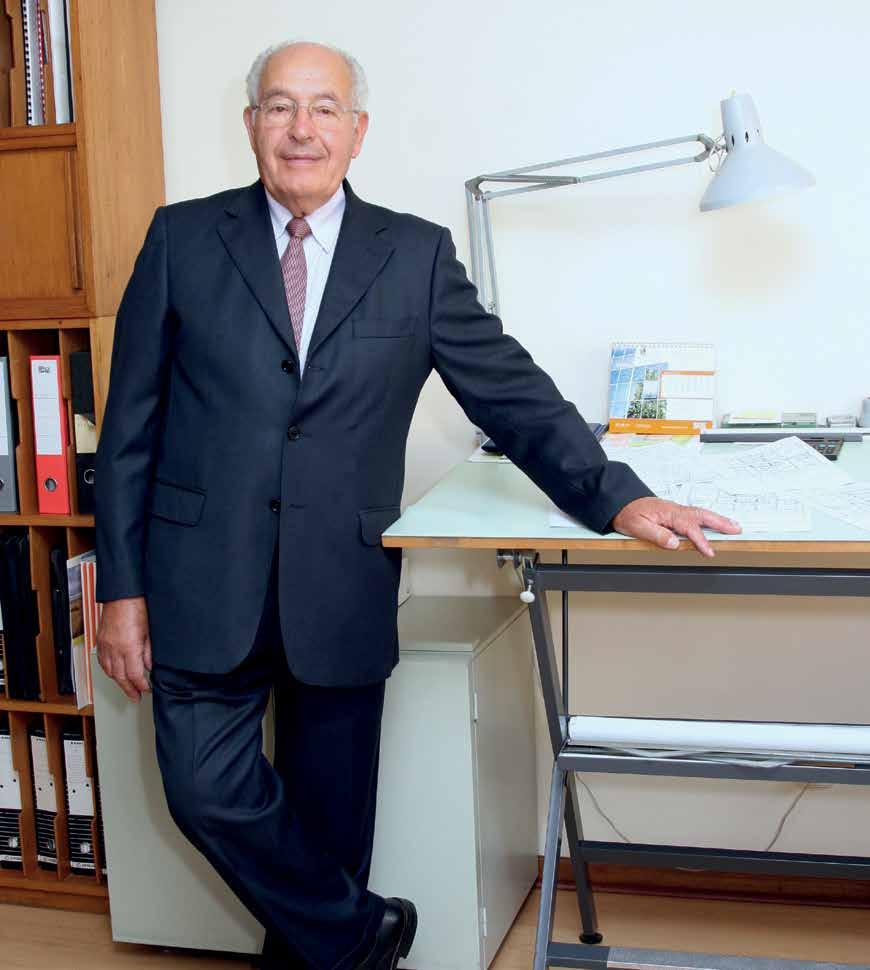
Esta história começou no dia 23 de Setembro do ano de 1935 em São Pedro, concelho de Tomar. Foi nesta terra que nasceu, deu os primeiros passos, começou a falar, que cresceu e aprendeu a fazer parte de uma família muito grande e que iria aumentar mais tarde em Lisboa.
By Joaquim Pereira deJuly 2011
Joaquim da Costa Santos mantém o amor à sua terra natal e a ela gosta de voltar para a visitar e aos seus familiares que por lá ficaram mas foi na capital portuguesa que construiu a sua vida pessoal e profissional.
Em Junho de 1946 concluiu o exame da 4ª classe e em Agosto, com 11 anos de idade chegou pela primeira vez a Lisboa. Veio para acompanhar o pai que tinha conseguido um trabalho na construção civil. Para o jovem tomarense foi uma aventura mas não de lazer e diversão. A sua missão era ajudar o pai. Ainda trabalhou numa mercearia e taberna e vendia copos de vinho. Depois muda-se para o Bairro de Caselas e por nove escudos por dia foi servente de pedreiro, dormia nas obras e fazia a sua comida. A obra no Bairro de Caselas era o seu local de trabalho e de vida.
Mas a sua primeira experiência de trabalho foi interrompida um ano depois. Por doença
do pai foi necessário regressar a Tomar. E só em 1949, com 14 anos regressou, desta vez sozinho à capital portuguesa para continuar o que tinha sido interrompido. Voltou à construção civil e a servente de pedreiro. «Aprendi a profissão de pedreiro e em 1961 fiz a primeira empreitada como encarregado de obra na rua das Amoreiras em Campolide», lembra Joaquim da Costa Santos. Nesta profissão, o jovem tomarense fez todo o trabalho, desde pedreiro, carpinteiro, ladrilhador, e armação de ferro. E ainda se lembra do valor da primeira empreitada como chefe de obra, 220 contos para construir dois prédios com cave, rés-do-chão e três andares. Depois deste trabalho, foram mais dois na rua Capitão Ramires. E por aí continuou a construir em toda a Lisboa. Ainda se lembra de praticamente todos os prédios que ajudou a erguer. «Em 1964 tomei de empreitada um edifício para a firma Engenheiro Costa Martins e Irmão e só para esta empresa fiz mais 33 prédios de empreitada. Depois também construí alguns prédios para a firma Oriobiri de Manuel Ribeiro».
É com alguma saudade que Joaquim da Costa Santos lembra estes tempos, sobretudo

quando passa por eles depois destes anos todos. «Antigamente o trabalho era mais duro porque a maior parte era realizada manualmente, não existiam as máquinas de hoje, mas sinto saudades porque as coisas eram mais simples, trabalhava-se com mais brio, as pessoas gostavam de fazer o seu trabalho, tinham uma profissão. Hoje querem um emprego».
O empresário recorda esses tempos com alguma nostalgia. Fazendo comparação com o momento actual, revela que naquela época havia menos burocracia, «sabíamos que tínhamos de fazer aquele trabalho e fazíamos com profissionalismo. Ganhava-se menos mas os produtos mantinham-se nos mesmos preços por muitos anos».
O casamento aconteceu em 1958 e ainda se lembra quando ganhava nessa altura, 45 escudos por dia, o que dava 270 por semana. Pagava 100 escudos por mês pela renda de um quarto e conseguia comer com a mulher e ainda conseguia poupar,
A 7 de Novembro de 1973 funda a sua própria
empresa, a Jocosan. Quando fez o primeiro prédio os apartamentos venderam-se todos num instante. Foram tempo bons para quem construía. Hoje, Joaquim da Costa Santos revela que se vivem tempos muito difíceis e que em todos os anos de actividade nunca assistiu a uma crise como esta. «Temos dificuldade em vender e muitos encargos com o banco. Neste momento tenho 22 apartamentos para vender e 10 lojas e estou a construir mais 30 e quatro lojas, tudo num investimento de 10,5 milhões de euros, nos quais tenho encargos bancários».

Uma vida repleta dedicada à construção da capital portuguesa. No seu portfólio estão muitos dos prédios que ocupam as ruas de Lisboa e que lhe trazem muito orgulho. Pela sua experiência e dedicação à profissão, foi sócio-fundador da Associação dos Industriais da Construção de Edifícios - AICE, com o número 66. Chegou a presidente da associação em 2000 e manteve-se até 2004. Com tanta entrega ao trabalho, naturalmen-
Antigamente o trabalho era mais duro porque a maior parte era realizada manualmente, não existiam as máquinas de hoje, mas sinto saudades porque as coisas eram mais simples. Back then the work was tougher because most of it was done manually, there weren’t the machines you have today, but I miss it because things were simpler back then.”
te que a família também acabou por absorver esta paixão. Em 1994 fundou outra empresa de construções, a LisSantos - Gestão e Empreendimentos Imobiliário, Lda, com o filho José Manuel da Costa Santos e o genro Agostinho Moura Gonçalves. Mesmo com tanta actividade Joaquim da Costa Santos, reconhece que hoje a construção passa por momentos difíceis. Acredita que com as medidas da Troika, a construção nova irá terminar e muito do parque habitacional não dá para reabilitar. Reconhece que a maior parte da construção de Lisboa foi feita pelo designado ‘Pato Bravo’. Mas muita
foi realizada por profissionais da construção. Homens que como ele que sempre trabalharam na construção civil. Que sabiam o que faziam, sabiam do ofício. Também considera que nos tempos actuais a construção dos interiores é superior, os acabamentos são muito melhores, contudo, com as fachadas já não acontece o mesmo.
Ainda no activo, Joaquim da Costa Santos não é homem de estar sempre a pensar no passado. Reconhece que quando passa por ruas onde estão prédios que construiu sente saudades e que aquele que mais gostou de fazer é precisamente o prédio onde mora com a sua mulher. Na zona de Benfica, na rua Tenente Coronel Ribeiro dos Reis, nº 16, construído há 15 anos, o edifício de 21 andares é um marco na sua carreira.

Apesar de ser um homem do presente, o empresário não esquece os amigos que o acompanharam no seu percurso profissional. «Tenho muitos amigos que estiveram comigo desde o início. Tenho um grupo deles de há 40 anos e que todas as terças-feiras almoçamos. Somos 25 pessoas que se tornaram uma família.
A grande família e que é quase toda oriunda da zona de Tomar. Em meados do século XX grande parte dos construtores dos edifícios de Lisboa eram originários desta região do país. Os tomarenses João Vicente Martinho, Manuel de Matos e Manuel Vicente foram os grandes pioneiros desta aventura. Foram eles que iniciaram a indústria da construção de prédios para venda na capital portuguesa. A esta grande iniciativa e que teve seguimento chamaram-lhe “Milícia dos Construtores Tomarenses”. Em 1906, estes três homens juntaram as suas economias, compraram um lote de terreno na Rua António Pereira Carrilho, ao preço de dois mil réis o metro quadrado e edificaram o seu primeiro prédio que ficou com o número 32. Terminada a obra venderam o prédio pela quantia de seis contos, o que na altura foi muito compensador. Iniciava-se assim a modalidade da construção para venda.
As portas estavam abertas para a indústria das edificações urbanas para venda e com ela a chegada à capital de muitos trabalhadores da região de Tomar. Esta fantástica história dos construtores de Tomar, desconhecida pela maioria dos portugueses, foi descrita em livro por Fílipus Populi, em 1946 com o
título “Os construtores civis tomarenses e o desenvolvimento da construção urbana em Lisboa”.
Uma linhagem de profissionais tomarenses que vieram para a capital com o intuito de construir edifícios. Segundo Fílipus Populi, a actividade destes construtores desdobrou-se em duas fases: a da cal e areia e a do cimento armado. Mais de um século em que estes profissionais ajudaram a dar a imagem que hoje Lisboa apresenta. Ficaram conhecidos pelos lisboetas por ‘Patos Bravos’, pelo facto de virem em conjunto das suas terras e manterem a sua unidade. Uma designação que nunca mais deixaria de ser utilizada no sector da construção.
Joaquim da Costa Santos é um dos homens do tempo do cimento armado e faz parte da grande família de construtores tomarense. Uma herança que tem orgulho em carregar e passar para os seus filhos e quatro netos. Mas este empresário não vive agarrado ao passado e esteve sempre em sintonia com o

progresso. Em 1987 introduziu as novas tecnologias no seu negócio. Sempre atento ao desenrolar e à progressão das suas obras. «Quando terminava o meu dia na obra vinha sempre para o escritório. Antes era tudo feito na barraca das obras mas com a profissionalização do sector eu acompanhei esse processo. Sempre gostei de ter o meu cantinho de trabalho. Mesmo quando antes os negócios se faziam apenas pela palavra, por um aperto de mão, tudo na base de confiança. O mal deste sector foi ter entrado muitas pessoas que não tinham conhecimento da construção. Foi um período em que qualquer pessoa construía. Claro que actualmente constrói-se com mais qualidade mas mesmo assim também ainda existe boa e má construção».
This story began on September 23, 1935 in São Pedro, in the Tomar district. It was here that he was born, took his first steps, began to talk, grew up and learnt to be part of a very large family that would later increase in Lisbon.
liked to have my own work corner. Even when before business was done over conversation and a handshake, and all based on trust.”
Sempre gostei de ter o meu cantinho de trabalho. Mesmo quando antes os negócios se faziam apenas pela palavra, por um aperto de mão, tudo na base de confiança.
I’ve always
Joaquim da Costa Santos retained a love for his native village and likes to return to visit his family who remain there, but he built his personal and professional life in the Portuguese capital.
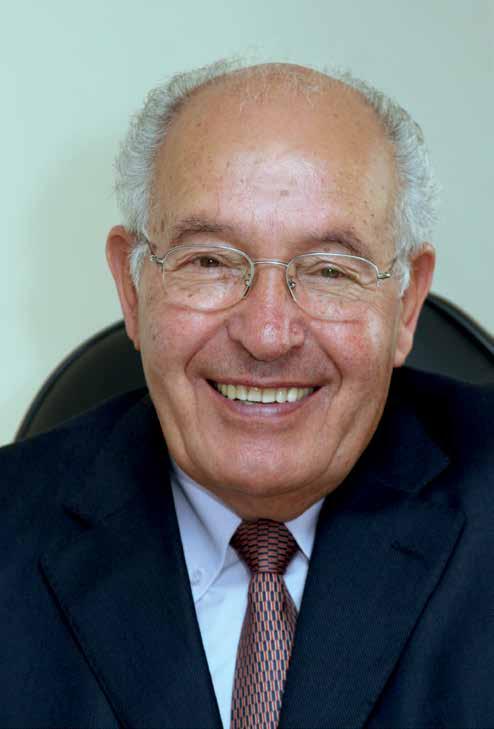
In June 1946 he completed his secondary school and went to Lisbon for the first time at the age of 11. He came along with his father who got a job in civil construction. It was an adventure for the young lad from Tomar, but
not one of leisure and fun. His mission was to help his father. He even worked in a grocery shop and tavern selling glasses of wine. He then moved to the Caselas neighbourhood and for nine escudos per day was a stonemason’s apprentice, slept on site and made his own food. The building site in the Bairro de Caselas was his place of work and life. But his first work experience was interrupted a year later. Because of his father’s illness he had to return to Tomar. And it was only in 1949 aged 14 that he returned alone to the Portuguese capital to continue what had been interrupted. He returned to civil construction as a stonemason’s apprentice. “I learnt the stone masonry profession in 1961 and did my first building project as a foreman in Rua das Amoreiras in Campolide”, recalls Joaquim da Costa Santos.
In this profession, the young lad from Tomar did all the work from masonry and carpentry to tiler, and steel framework. And he still recalls the amount he got as works foreman which was 220 contos (220,000 Escudos or €2,200) to build two buildings with basement, ground floor and three floors. After this project, he did two more on Rua CapitãoRamires. And from there on he continued building all over Lisbon. He still remembers all the buildings that he helped to build. “In 1964 I took on the site management of a building for the firm Engenheiro Costa Martins &Irmão and for this company alone did 33 more building projects. I then built some buildings for the firm Oriobiri owned by Manuel Ribeiro”.
Joaquim da Costa Santos recalls these times with some nostalgia, particularly when he passes buildings after so many years. “Back then the work was tougher because most of it was done manually, there weren’t the machines you have today, but I miss it because things were simpler back then, I worked with more gusto, people liked their work, and they had a profession. Today they want a job.”
The entrepreneur recalls these times with some nostalgia. Making a comparison with now, he reveals that at that time there was less red tape. “We knew what we had to do in that work, and we did it professionally. I earned less but the products stayed at the same prices for many years”.
He married in 1958 and still remembers when at that time he earned 45 escudos a day, which gave him 270 per week. I paid 100 escudos per month to rent a room and food for me and my wife and even managed to save.
On November 7,1973 he founded his own firm, Jocosan.
When he did his first apartment building, he sold them all straight away. They were good times for those who were builders. Today, Joaquim da Costa Santos reveals that times are hard and that the sector has never seen such a crisis. “We have difficulties in selling and many responsibilities with the bank. Right now, I have 22 apartments to sell, 10 shops and I am building 30 more and four shops, in a €10.5 million investment for which I have bank loans to service.
A fulfilled life dedicated to building in the Portuguese capital. He has many buildings in his portfolio on Lisbon’s streets that he is proud of. For experience and dedication to his profession he co-founded the Building Construction Industry Association (AICE) with membership number 66. He became its president in 2000 and he remained so until 2004. With so much dedication to his work, naturally his family also took on his passion. In 1994 he founded another construction company, LisSantos - Real Estate Management, Lda with his son José Manuel da Costa Santos and
his son-in-law Agostinho Moura Gonçalves. Even with so much activity, Joaquim da Costa Santos recognises that today construction is going through some difficult times. He believes that with the Troika measures, new build will stop and much of the existing housing stock won’t be refurbished. He recognises that most of the building work done in Lisbon was by ‘cowboys’. But a lot was done by true professionals. Men like him who had always worked in civil construction. Who know what they are doing and know their profession. He also thinks that these days the construction

Joaquim da Costa Santos é um dos homens do tempo do cimento armado e faz parte da grande família de construtores tomarense. Uma herança que tem orgulho em carregar e passar para os seus filhos e quatro netos.
Joaquim da Costa Santos is one of those men who since the advent of reinforced concrete are part of this large family from Tomar. It is a legacy that he is proud to carry and pass on to his children and four grandchildren.”
of interiors is better, the finishings are much improved, however the same can’t be said of the façades.
Still active, Joaquim da Costa Santos is not a man who’s always dwelling in the past. He admits that when he passes streets with buildings he did, he feels a sense of pride but the one he most liked building is the one in which he lives with his wife. The 21-floor building on Rua Tenente Coronel Ribeiro dos Reis 16 in Lisbon’s Benfica that he built 15 years ago was a milestone in his career.
Despite being a man of the moment, the entrepreneur has never forgotten the friends that accompanied him throughout his career. “I have many friends that have been with me since the beginning. I have a group I’ve known for 40 years, and we have lunch on Tuesdays. There’s 25 and we’ve become a family.
“Tomar
This big family of builders almost all come from the Tomar district. In the middle of the XXth century a large part of Lisbon builders came from this region. João Vicente Martinho, Manuel de Matos and Manuel Vicente were the great pioneers of this adventure. They were the ones who began constructing buildings for sale in the Portuguese capital. They eventually called this great movement the ‘Tomar Builders Militia’. In 1906 these three men pooled their resources and bought a plot of land on Rua António Pereira Carrilho for 2,000 Reis per square metre and put up their first building at number 32. On com-
pleting the project, they sold the building for around six contos, which at the time was a great deal. That was how they began building for sale.
The doors were opened to urban build to sell, and with it many workers from the Tomar region poured into the capital. This amazing story of Tomar builders, not known by most Portuguese, was described in a book by Filipus Populi in 1946 with the title ‘Tomar’s Civil Constructors and Urban Construction Development in Lisbon’.
A line of Tomar professionals that came to the capital with the aim of building buildings. According to Filipus Populi, the activity of these builders unfolded in two phases: the mortar and sand and reinforced concrete. More than a century when these professionals helped to create the image that we have of Lisbon today. They were known by the Lisboners as Wild Ducks’ because they came together from their native region and kept together. A label that has continued to be used in the construction sector.
Joaquim da Costa Santos is one of those men who since the advent of reinforced concrete are part of this large family from Tomar. It is a legacy that he is proud to carry and pass on to his children and four grandchildren.


But this entrepreneur is not living in the past and is always in sync with progress. In 1987 he introduced new technology to his business. Always aware of progress and the progression of his projects. “When I finished my day on site, I always dropped by the office.
Before office work was all done in the building site cabin but with the professionalisation of the sector I accompanied this process. I’ve always liked to have my own work corner. Even when before business was done over conversation and a handshake, and all based on trust. The worst thing for the sector is that many people came in and had no knowledge about construction. It was a period when anyone could be a builder. Of course, today building is better quality, but even so there is still bad construction”. Como
criar um bom ambiente dentro de casa.
LeapAssets
Community living on Lisbon’s doorstep

Georges Bou Jaoude, managing director da LeapAssets, deu-nos a conhecer a visão e filosofia desta empresa que cedo compreendeu as urgências nacionais em matéria de habitação. Mas foi na festa de apresentação do novo desenvolvimento urbano de Torres Vedras que fomos seduzidos pelo projecto Portela da Villa.
Georges Bou Jaoude, Managing Director of LeapAssets has revealed his vision and philosophy of his company which grasped early Portugal’s urgent housing problem. But it was at the presentation party of the new urban development in Torres Vedras that we were seduced by the Portela da Villa project.

Na breve conversa que tivemos com o managing director da LeapAssets facilmente percebemos que detém um conhecimento profundo sobre as necessidades habitacionais de Portugal, sobretudo das “famílias e jovens”. Mas o que mais nos atrai na sua pessoa é o seu saber arriscar e ir além da zona de conforto do tradicional e seguro investimento imobiliário na capital portuguesa.
Torres Vedras é, nas suas palavras, “uma das zonas mais promissoras para a expansão residencial de Lisboa”. E é aqui, precisamente, que vai nascer o desenvolvimento urbano Portela da Villa.
Para se ter a noção da dimensão e importância deste projecto basta dizer que a empresa adquiriu 119 lotes, vai trazer para o mercado 800 novos fogos e prevê a fixação de 3.000 residentes. Aqui haverá também lugar para espaços de comércio, serviços, lazer, desporto, conveniência e extensas áreas verdes.
O investimento ascende a 200 milhões de euros, que será aplicado de forma faseada e através de diversos modelos de parceria a nível de investimento e promoção.
Este é um projecto que está a ter um forte impacto e a suscitar grande curiosidade na coroa de Lisboa. E não é para menos, já que a sua localização geográfica não podia ser mais estratégica. O Portela da Villa situa-se a cinco minutos de Torres Vedras e a apenas 30 minutos de Lisboa, na saída 9 da A8 e com excelentes acessos viários quer para a capital, quer para outros pontos da região Oeste e de todo o País. Como Georges Bou Jaoude refere: “Conjuga bons acessos e proximidade a uma capital eu-
ropeia, com um estilo de vida de uma cidade, bem servido de serviços, comércio, saúde e ensino, cultura e lazer. É uma cidade perto da praia e tranquila, mas simultaneamente muito virada para o futuro ao nível de ambiente e tecnologia, além de estar empenhada em melhorar a sua conectividade em termos de mobilidade e ligações de transportes”.
A excelência da oferta é outro plus a que ninguém fica indiferente. O primeiro empreendimento a conhecer a luz do dia é o Jacarandá e o “seu sucesso vai definir como se desenvolve o resto do empreendimento”, avança Georges Bou Jaoude, que recorda igualmente que “o desenvolvimento do Jacarandá acontece em simultâneo com o desenvolvimento da electrificação da linha de comboio que liga Torres a Lisboa, obra que estará concluída dentro de um ano, e que vai permitir ainda melhores acessos” a este empreendimento.
O Jacarandá deverá estar concluído no 3º trimestre de 2025 e vai disponibilizar 16 unidades nas tipologias T2 e T3, com áreas entre os 74 metros quadrados (m2) e os 138 m2, às quais acrescem amplas varandas e terraços, que no caso das tipologias de maior dimensão poderão contemplar espaços adicionais de 40 m2 Excelente luz natural, organização funcional flexível, equipamentos de qualidade, materiais sustentáveis e uma forte aposta na eficiência energética fazem deste empreendimento o mais adequado aos requisitos da vida contemporânea.
Na festa de lançamento do primeiro núcleo de apartamentos ficámos a saber que já entraram em fase de pré-reserva comercial e a preços convidativos que se iniciam nos 240 mil euros. Além destas novas unidades, estão já em cons-
trução e em fase de comercialização duas moradias em banda, com áreas interiores de cerca de 280 m2, com piscina e jardim privado, além de dois lugares de estacionamento coberto. Portela da Villa apresenta-se como um projecto que vai além de quatro paredes para morar. É um espaço para viver, conviver e partilhar experiências de vida mais positivas, com maior mobilidade e muito sustentáveis. É um local de vizinhança e socialização, uma vez que incluirá zonas de lazer e bem-estar como uma pista de fitness, uma horta comunitária e uma área de barbecue e piquenique. De desfrute da natureza, pois incluirá um jardim público com quiosque e esplanada. E onde não faltou a preocupação com os nossos amigos de quatro patas, por isso, haverá também áreas de apoio para os animais de estimação.
Refira-se que o primeiro investimento da LeapAssets na região deu-se ao nível da educação com a aquisição da Escola Internacional de Torres Vedras. Segue-se agora o Portela da Villa. No horizonte da empresa está ainda Lisboa nas áreas de hospitality, com o Hotel Alegria localizado na Praça da Alegria e que dentro em breve será alvo de expansão, e habitação,
com projectos premium, de menor escala e nas áreas próximas da Avenida da Liberdade, bem como Marvila e Beato.
Na festa de apresentação do Portela da Villa, que decorreu num ambiente descontraído ao ar livre e que contou com a presença de ilustres convidados, a presidente da Câmara Municipal de Torres Vedras agradeceu este “mega investimento” na região. Laura Rodrigues recordou que esta é uma zona geograficamente rica, perto de praias de bandeiras azul e de Lisboa, com infra-estruturas de qualidade e é um território que tem crescido muito nos últimos anos. Para a autarca, este desenvolvimento urbano é o espaço físico ideal para famílias que queiram viver com qualidade e em contacto com a natureza.
O Portela da Villa pretende, acima de tudo, promover, nas palavras de Georges Bou Jaoude, “a boa qualidade de vida em termos de conforto, segurança, sustentabilidade e mobilidade”. Ali, vai ser possível sentir-se e experienciar-se o verdadeiro espírito de comunidade.
In the short chat that we had with the managing director of LeapAssets, we quickly grasped that he had a deep knowledge on Portugal’s housing needs, particularly for “families and
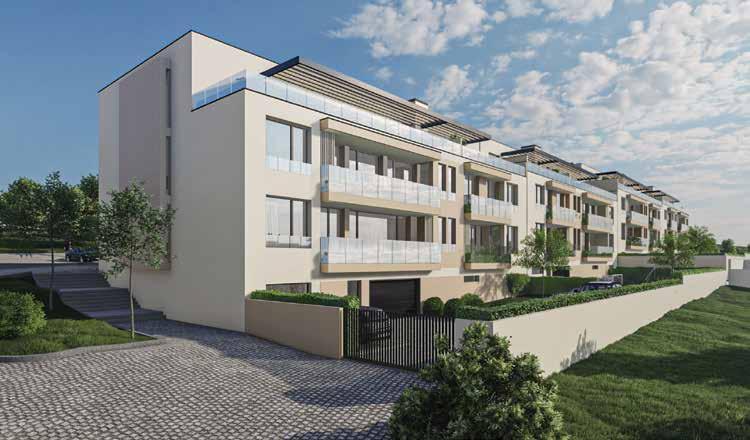
Torres Vedras é uma das zonas mais promissoras para a expansão residencial de Lisboa. E é aqui, precisamente, que vai nascer o desenvolvimento urbano Portela da Villa.
Torres Vedras is one of the most promising areas for Lisbon residential expansion. And it is precisely here that the Portela da Villa urban development will be created.”
young people.” But what most drew us to his personality is his knack of knowing how to take a risk beyond his comfort zone of traditionally secure real estate investment in the Portuguese capital.
Torres Vedras is, in his words, “one of the most promising areas for Lisbon residential expansion.” And it is precisely here that the Portela da Villa urban development will be created.

To have an idea of the size and importance of this project it is suffice to say that the company has acquired 119 plots which will bring 800 new homes to the market and foresees 3,000 new residents. The project also envisages space for trade and retail, services, leisure and sports facilities and extensive green areas.
The investment tops 200 million euros which will be applied in phases and through various partnership models at the level of investment and development.
This is a project that is having a strong impact and is arousing great curiosity on the outskirts of Lisbon. And for good reason since its location could not be more strategic. Portela da Villa is just five minutes from Torres Vedras and just 30 minutes from Lisbon on Exit 9 of
the A8 motorway and has excellent accesses to both various points of the city, the West Region, and the rest of the country.
As Georges Bou Jaoude says: “It combines good road accesses with proximity to a European capital offering a city lifestyle enriched by services, shops, health, education, culture, and leisure. It is a quiet town close to the beach but at the same time is forward looking in terms of the environment and technology, not to mention being committed to improving its connectivity in terms of mobility and transport links.”
The excellent offer is another plus which cannot be ignored. The first development to see the light of day is the Jacarandá and “its success will define how the rest of the development develops” says Georges Bou Jaoude who also reminds that the development of Jacarandá will take place at the same time as the electrification of the Torres-Lisbon train line takes place, a project that should be completed within a year, and will also enable better accesses” to this development.
Jacaranda is expected to be completed in the 3rd quarter of 2025 and will provide 16 twoand three-bedroom homes with areas of between 74 square metres (m2) and 138 m2 not



including the generous verandas and terraces which in the case of larger-size homes may include additional spaces of 40 m2. Excellent natural light, the interior spaces organised in a flexible and functional way, quality appliances, sustainable materials and a strong focus on energy efficiency make this development supremely suitable for contemporary living. At the launch party for the first apartments, we learnt that they were already being offered for off-plan reservation at attractive prices that start at 240,000 euros.
Apart from these new homes, two semi-detached homes are already under construction and are also being offered for sale off-plan, with interior areas of around 280 m2 with pool and private garden, and also covered parking for 2 cars.

Portela da Villa is a project that is so much more than living within four walls. It is a space to live, socialise, and share more positive life experiences with greater mobility and sustainability. It is a neighbourly and sociable place given that it will include leisure and wellness areas such as a fitness track, a community vegetable allotment, and a barbecue and picnic area. For those who enjoy the great outdoors it will also feature a public garden with a kiosk and esplanade. And it is an ideal place for dogs with areas set aside for pets.
It is worth mentioning that the first investment in the region from LeapAssets was at the level of education with the acquisition of the Torres Vedras International School. Portela da Villa now follows. Lisbon is still in the company’s sights in the hospitality area with the Hotel Alegria on the square Praça da Alegria which will soon be expanded, and housing, with premium projects on a lesser scale off Avenida da Liberdade, Marvila and Beato.
At the Portela da Villa presentation cocktail that took place in a relaxed open-air environment and included several local dignitaries, the mayor of Torres Vedras expressed her gratitude for this “mega investment” in the region. Laura Rodrigues drew attention to a geographically rich area, close to blue flag beaches and Lisbon, with quality infrastructures and in an area which has grown significantly in recent years. The mayor says that this urban development is the ideal place for families who want to enjoy quality living and be around nature.
Portela da Villa above all aims to foster, in the words of Georges Bou Jaoude, “a good quality of life in terms of comfort, security, sustainability and mobility.” There you can feel and experience the true spirit of community.
É um projecto que conjuga bons acessos e proximidade a uma capital europeia, com um estilo de vida de uma cidade, bem servido de serviços, comércio, saúde e ensino, cultura e lazer. It is a project that combines good road accesses with proximity to a European capital offering a city lifestyle enriched by services, shops, health, education, culture, and leisure.”



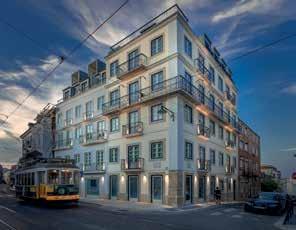


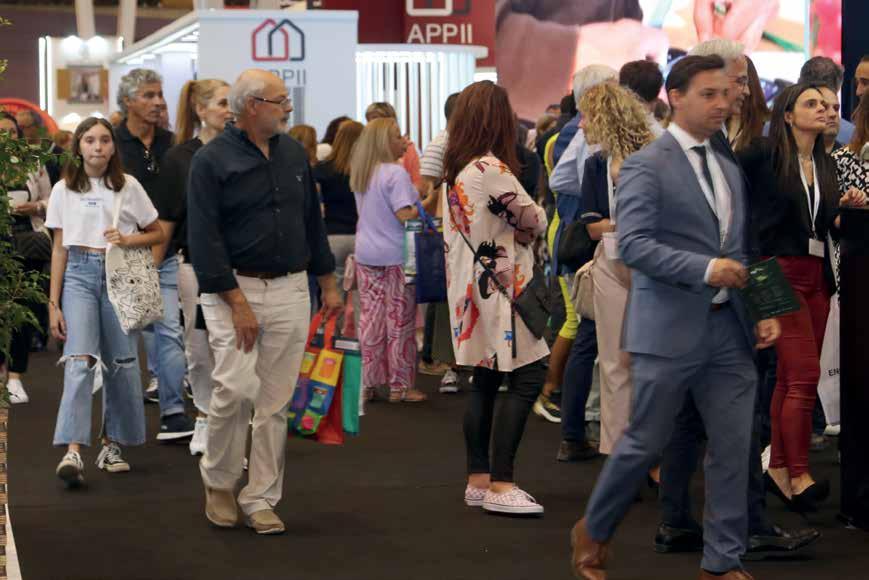
In a year in which housing in Portugal is the talk of the town here and abroadand not always for the best of reasons -, the doors of the Portuguese Property Fair (Salão Imobiliário de Portugal (SIL)) closed on May 7 with 47% more visitors than in 2022.
De 4 a 7 de Maio, foram 22.512 os visitantes registados naquela que é a maior feira do sector imobiliário em Portugal. Um aumento significativo face aos últimos três anos, marcados por um contexto sem precedentes, e que foi particularmente notado no primeiro dia do evento.
A 4 de Maio o SIL foi o “hottest spot to be in” para todos os players do sector, sendo o grande destaque a realização de mais de 100 “side events” durante os quatro dias da feira.
Quanto às propostas dos promotores, este ano houve uma clara aposta em aumentar e melhorar os stands e espaços de apresentação. Fica a sensação de que - em ano de incertezas no sector, com uma nuvem de “optimismo cauteloso” e um pacote chamado “Mais Habitação” -, os investidores querem mostrar que continuam em grande, estão para ficar e não têm nada a temer. Vamos deixar o tempo mostrar se é mesmo assim… O que não faltou foram oportunidades para falar sobre o tema quente da crise na habitação que o País atravessa: o SIL recebeu conferências e debates com diversos oradores, como a Conferência SIL CIDADES – “Os Desafios na Habitação” ou a Conferência SIL INVESTMENT PRO powered by APPII – “O Estado da Nação do Imobiliário | da Habitação | do Licenciamento”, que contaram com de mais de 600 participantes.
A Magazine Imobiliário esteve presente em todos os eventos e a conversa entre os especialistas repetiu-se: problemas com li -
cenciamentos; o Estado deve ser o grande responsável por garantir o direito de todos os cidadãos à habitação; e os privados estão disponíveis para construir habitação a preços acessíveis, desde que o Estado esteja disposto a colaborar. Este foi o espaço para reflectir e tentar encontrar soluções em conjunto.
Nota ainda para os Prémios SIL cujo evento decorreu num agradável ambiente de festa e onde o claro destaque foi para a atribuição da Personalidade do Ano a Beatriz Rubio, CEO da Remax, por ser a individualidade que mais se evidenciou no último ano no mercado imobiliário português.
O Salão Imobiliário de Portugal está de regresso de 2 a 5 de Maio de 2024, para a sua 27ª edição.
From May 4, 22,512 visitors were registered at Portugal’s largest real estate fair. It was a significant increase on the last three years affected by unprecedented events with numbers that were particularly remarkable on the first day of the event.

On May 4 SIL was the hottest place to be at for all sector players, with particular emphasis on more than 100 side events over the four days of the fair.
As to what was on offer from the developers, this year they clearly went in for bigger and better stands and presentation spaces. There was a feeling that - in a year of uncertainties for the sector, with a “ray of cautious optimism between the clouds” and a
Num ano em que a habitação em Portugal anda nas bocas do mundo - e nem sempre por boas razões -, as portas do Salão Imobiliário de Portugal (SIL) fecharamse, a 7 de Maio, com mais 47% de visitantes face a 2022.Texto Text: Madalena Guinote Ramos
package called ‘More Housing’ -, investors want to show they continue to be on form, are here to stay, and have nothing to fear. We will have to wait and see if it is really like that.
There was no shortage of opportunities to talk about the hot topic of the housing crisis that the country is going through: SIL hosted conferences and debates with a wide range of speakers such as the SIL CITIES Conference - ‘The Challenges of Housing’ or the SIL INVESTMENT PRO Conference powered by the APPII - ‘The State of the Nation I Housing I Licensing’, which had 600 participants. Magazine Imobiliário was at all the events and the conversation among the specialists
Os portugueses já se habituaram a pagar a taxa turística, somos um povo de “brandos costumes” e acreditamos que o valor cobrado vai ser bem utilizado. Ainda assim, todos ficaram contentes quando o Governo dos Açores revogou o seu pagamento na região. Já em Olhão, vai aplicar-se neste Verão.
No período pós-Covid esta taxa parece ter disparado em muitos países à volta do mundo, que o digam os vizinhos espanhóis. Se Valência anunciou a introdução desta taxa, já Barcelona revelou que a mesma vai aumentar nos próximos dois anos.
Recorde-se também que, a partir de 2024, os cidadãos não pertencentes à União Europeia vão ter pagar sete euros para poderem entrar nas fronteiras comunitárias.
É caso para dizer: Ainda não gozaram as férias e já começaram a pagar…
The Portuguese are now used to paying tourist tax, we are a trusting people with soft hearts and believe that the amount charged will be put to effective use. Nevertheless, we were all happy when the Government of the Azores revoked its payment in the region. But they are applying the tax in Olhão this summer.
was the same: problems with licencing; the State should be largely responsible for ensuring the right of all citizens to housing; and the private sector is available to build affordable housing if the State is open to cooperating. This was the place to reflect and try and find solutions together.
A note too on the SIL Awards that took place in a pleasant party environment in which, of course, all the attention was on the Personality of the Year award which went to Beatriz Rubio, CEO of Remax, for being the individual that most stood out over the past year in the Portuguese real estate market.
The Portugal Property Fair (SIL) will return between May 2-5, 2024, for its 27th edition.


In the post-Covid period this tax seems to have been introduced in many countries around the world according to our neighbours in Spain. If Valencia has announced the introduction of this tax, then Barcelona has revealed that it will put up its tax over the next two years.
It will be remembered too that from 2024 non-European Union citizens will have to pay seven euros to cross community borders.
It is a case of saying: They have not even started their holidays and are already paying...
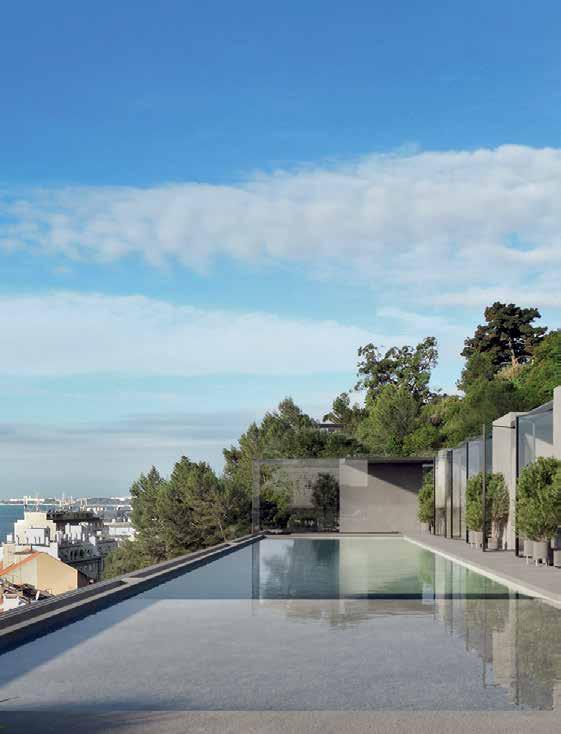
Sector “Oscars”
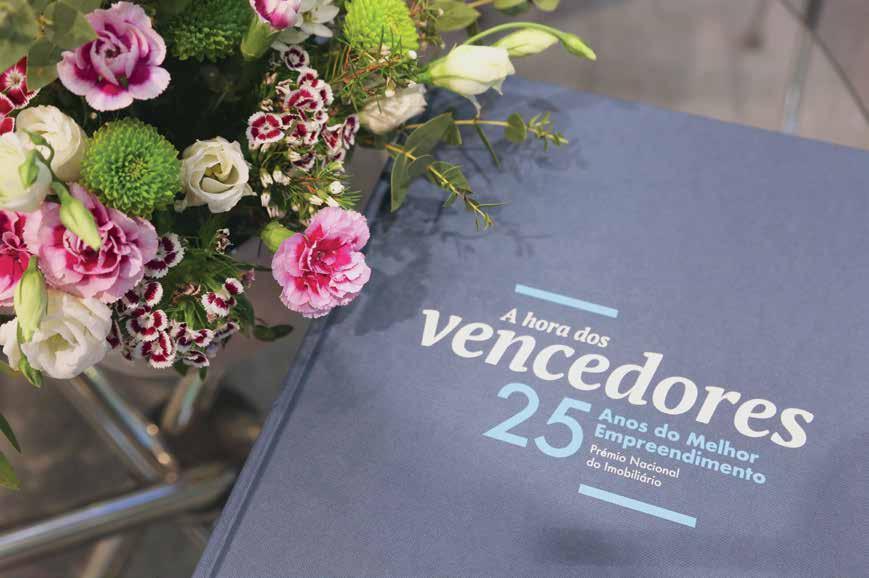
O livro comemorativo “A Hora dos Vencedores – 25 Anos do Melhor Empreendimento do Ano”, lançado pela Magazine Imobiliário em homenagem aos 25 anos do Prémio Nacional do Imobiliário, decorreu num ambiente de celebração e convívio no Salão Imobiliário de Portugal, no stand da Cidade APPII numa parceria com a Associação Portuguesa de Promotores e Investidores Imobiliários. Deixamos alguns dos momentos mais marcantes.
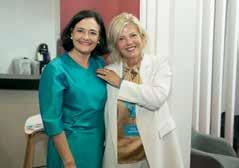


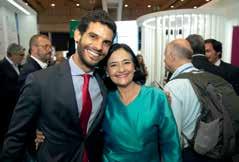



The commemorative book ‘The Hour of Winners - 25 Years of the Best Development of the Year’ published by Magazine Imobiliário took placein an atmosphere of celebration and socialising at the Portugal Property Fair (SIL), at the stand Cidade APPII in a partnership with the Portuguese Association of Developers and Real Estate Investors. Here are some of the most important moments.



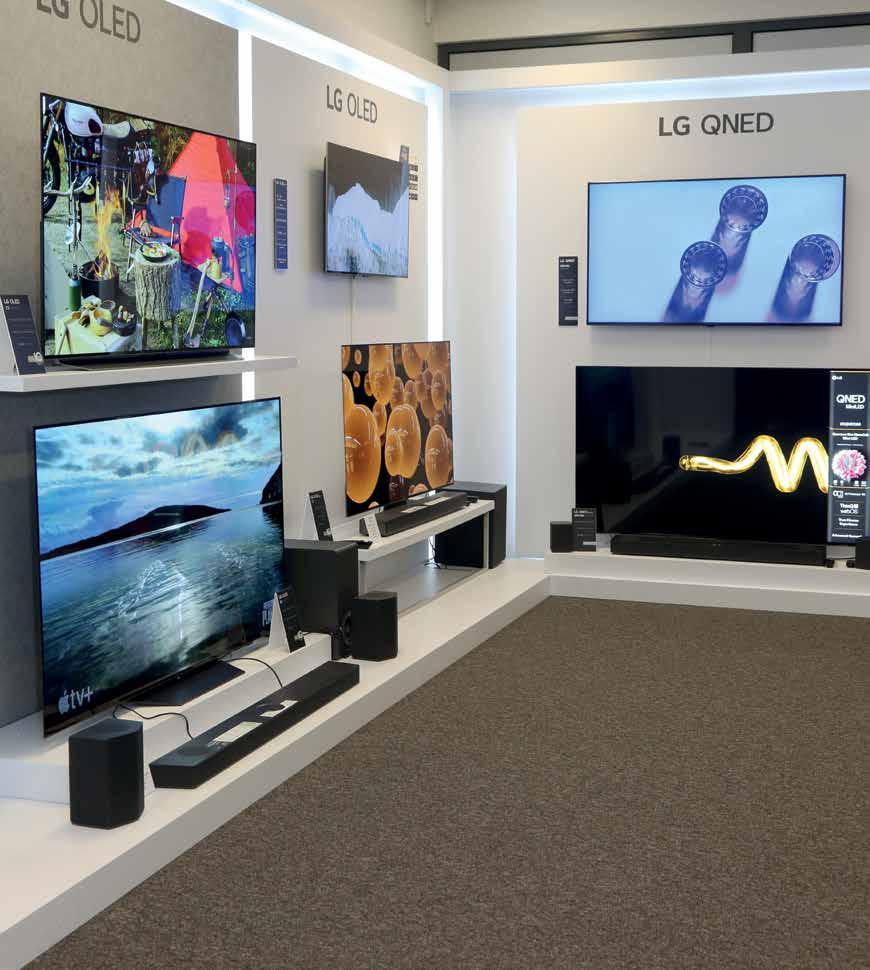
Quite naturally and without even realising it we have been invaded by technology from South Korea. As the Director of Marketing at LG Electronics Portugal, Hugo Jorge tells us, it has been a “peaceful invasion’ that has turned it into a reputable and brand which has been trusted by the consumer for 20 years.
A LG Electronics encontra-se a celebrar 20 anos da sua presença em Portugal. Apesar do actual director de Marketingseencontrarna empresa somente há 12 anos, consegue traçar-nos uma linha temporal onde recorda os primeiros passos no nosso País como “uma marca asiática com produtos interessantes a preços baixos.”Hoje, a sua força reside nas várias linhas de negócio e na diversidade de produtos de topo que se inserem no nosso pequeno, mas muito competitivo, mercado nacional.

A engenharia do produto foi determinante para esta evolução que do económico passou para a dianteira tecnológica, para um design apelativo e inovador, até chegar a gamas premium.
Hugo Jorge faz a ressalva para o facto de que esta notoriedade “não se faz num dia”, só é possível através de uma “estreita e forte relação com os parceiros, com as equipas da empresa e colaboradores e com os consumidores.”
Como o CEO da LG Electronics, William Cho, afirmou recentemente, numa estrutura de negócios voltada para o futuro “cada um de nós na LG é um ‘Value Creator’ (criador de valor) para os nossos clientes.”
Contudo, na actual conjuntura menos favorável, o consumo na área da electrónica está a cair e em algumas áreas acima dos 20%. A forma que a empresa encontrou para contornar este cenário foi através da “proximidade com os parceiros e apoiá-los nas suas iniciativas.” Hugo Jorge acrescenta também que “ao lan-
çar os nossos produtos no mercado estamos a contribuir para que essa quebra não seja tão significativa e a prova está na nossa share”. Com efeito, a LG trabalha em cinco áreas de negócio e diz que se encontra a “crescer em todas”. O amadurecimento do produto, a expansão dos segmentos B2B e B2C e as áreas de negócio associadas a conteúdos e serviços fizeram catapultar o crescimento exponencial da marca.
No imobiliário nacional esta é uma marca cujas soluções têm vindo a ser utilizadas em empreendimentos de maior ou menor escala, sobretudo no mercado residencial e hoteleiro. O actual pipeline da marca foi iniciado há um/ dois anos e Hugo Jorge confirma que estão a trabalhar com investidores, promotores, arquitectos, projectistas e instaladores. Tal “é fruto do excelente trabalho da nossa equipa de vendas que opera muito bem o canal que, por sua vez, está muito bem distribuído”. Para o efeito promovem também eventos, como webinares ou o LG Open Day, que permitem mostrar os produtos e juntar interesses e vontades entre todos os players.
É nestas iniciativas que muitas vezes se descobre que a marca vai muito além de um electrodoméstico, e que também tem soluções de armazenamento de energia de baterias ou bombas de calor, por exemplo. Há, pois, partilha de conhecimento que gera parcerias e lucro.
Sem darmos conta, de uma forma muito natural, fomos invadidos pela tecnologia sul-coreana. Como nos diz Hugo Jorge, director de Marketing da LG Electronics em Portugal, foi uma “invasão pacífica” que se transformou numa reputada marca e numa relação de confiança há já 20 anos.Texto Text: Carla Celestino
Então qual é o próximo passo? A LG depois de ter encerrado o negócio Mobile, passou a desenvolver o Vehicle Component Solutions associado à electrificação automóvel, não só
ao nível de baterias, mas de todas as componentes eléctricas, nomeadamente soluções de telemática 5G para fábricas e produtoras de veículos na Europa.
Posso afirmar que este ano e meio em que estive à frente da LG Portugal foi dedicado à continuidade e fortalecimento do trabalho que a equipa da LG tem vindo a desenvolver ao longo de quase duas décadas no mercado nacional. Neste sentido, tivemos como prioridade a construção e valorização de uma marca como a LG através do seu maior recurso – os produtos e as tecnologias inovadoras que traz para o mercado com o objectivo de fazer com que a vida dos consumidores seja melhor. Assim, “o Futuro é” ilimitado e entusiasmante e, para mim, é uma enorme honra poder fazer parte da história desta subsidiária de sucesso no panorama internacional da LG.
I can say that this year and a half that I was at the head of LG Portugal was dedicated to the continuity and strengthening of the work that the LG team has been developing over almost two decades in the national market. In this sense, our priority was to build and enhance a brand like LG through
with partners, the company’s team and staff, and consumers.”
As the CEO of LG Electronics, William Cho recently stated, in a business structure focused on the future “each one of us at LG is a ‘Value Creator’ for our customers.”
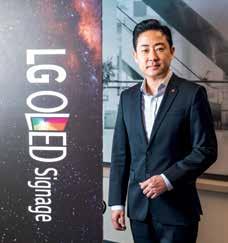
However, in the current less than favourable economic situation, consumerism in the electronics area is falling and in some areas by 20%. The way that the company managed to get around this situation was by working “closely with partners and helping them in their initiatives.” Hugo Jorge also adds that by “launching our products on the market we are contributing to ensuring that this fall is not too significant and proof of this lies in our market “share.”
In fact, LG is working in five business areas and says that it is growing in all.” The product maturity, the expansion of B2B and B2C segments and in business areas associated with content and services has catapulted the exponential growth of the brand.

In national real estate this is a brand whose solutions have been used in both large- and small-scale developments, particularly in the residential and hotel markets.
its greatest resource – the innovative products and technologies it brings to the market with the aim of makingconsumers’ lives better.
Thus, “the Future is” unlimited and exciting, and for me it is a great honor to be able to be part of the history of this successful subsidiary in the international landscape of LG.
A robótica é outra das apostas da marca a nível internacional. Hugo Jorge dá-nos o exemplo de um robot que à chegada ao aeroporto da capital sul-coreana além de guiar os turistas até à porta de saída limpa simultaneamente o chão. Fala-nos também dos exoesqueletos desenvolvidos para ajudar os trabalhadores nas tarefas mais pesadas. E ainda da área de software, onde o destaque vai para a aplicação ThinQ que permite muito facilmente conectarmo-nos com os electrodomésticos, mesmo estando fora de casa.
A LG surgiu para facilitar, melhorar e tornar mais aprazível a vida das pessoas e por isso, o sucesso seria inevitável. Portugal não é excepção.
Basta olhar à nossa volta e facilmente descobrimos o símbolo da marca num lar português: na televisão OLED que os filhos dos nossos vizinhos usam para jogar, no frigorífico side by side ou naquela máquina de lavar roupa silenciosa e eficiente que temos lá em casa, no ar condicionado de um hotel em que pernoitamos, nas ruas da cidade na sinalética led em outdoors de edifícios, lojas e até em rotundas com grande visibilidade…
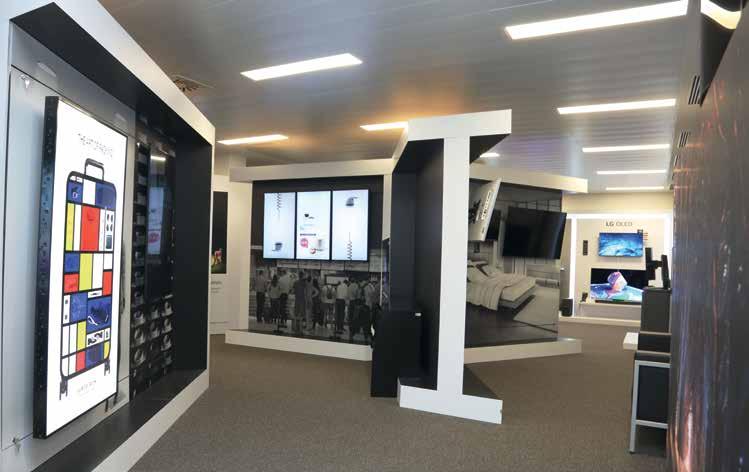
Há vida inteligente em cada solução LG. A marca está a ajudar a redefinir o futuro dos lares. Temos casas mais smart, eficientes e sustentáveis sem perder a experiência de algo que é tão nosso, que é tão português: desfrutar e partilhar o conforto e diversão dentro de quatro paredes. Como diz o seu slogan: “A vida é boa!”
LG Electronics is celebrating 20 years in Portugal. Despite the current director of marketing having been at the company for 12 years, he is able to draw a timeline which shows the company’s first steps in Portugal as “an Asian brand with interesting products at low prices. “Today, its strength lies in its various business lines and in the diversity of its top products that are sold in our small but very competitive national market.
Product engineering was vitally important for this evolution which from the economic passed to innovative technology, and an innovative and attractive design and on to the premium ranges.
Hugo Jorge stresses the fact that this reputation was “not built in a day” and is only possible through a “close and strong relationship
O amadurecimento do produto, a expansão dos segmentos B2B e B2C e as áreas de negócio associadas a conteúdos e serviços fizeram catapultar o crescimento exponencial da marca.
The product maturity, the expansion of B2B and B2C segments and in business areas associated with content and services has catapulted the exponential growth of the brand.”
The company’s current brand was begun one-two years ago and Hugo Jorge confirms that they are working with investors, developers, architects, designers, and fitters. That is the “fruit of the excellent work of our sales team that works their marketing channel very well which in turn is very well distributed.” To do this they also organise events such as webinars or LG Open Day which highlights their products and join the interests and desires of all players.
And it is at these initiatives that quite often it is discovered that the brand extends far beyond a household appliance, and has battery energy storage solutions or heat pumps, for example. Indeed, sharing know-how creates partnerships and profits.
So, what is the next step? After closing its mobile business, LG went on to develop the Vehicle Component Solutions associated to vehicle electrification, not just at the batteries level, but all electrical components, namely 5G telematic solutions for factories and vehicle producers in Europe.

Robotics is another of the brand’s investments internationally. Hugo Jorge gives the example of a robot which at arrivals at the airport of South Korea’s capital which in addi -
tion to guiding tourists to the exit, cleans the floor at the same time. He also tells us about the exoskeletons developed to help workers with heavy tasks. And in the software area too where he highlights the application ThinQ that easily connects us with our household appliances, even when we are not at home. LG is there to improve and make people’s lives easier and more enjoyable which is why its success will be inevitable. Portugal is no exception.
You only have to look around you to easily discover the brand’s logo in a Portuguese home: on the OLED televisions that our neighbours children use to play games, or on the side-byside fridge or that quiet washing machine, the air conditioning in the hotel where we’re staying, on our city streets on the LED billboard signs on buildings, shops and even on high visibility roundabouts.
There is intelligent life in every LG solution. The brand is hoping to redefine the future of homes. We have smarter, more efficient, and sustainable homes without losing the experience of something that is so ours and so Portuguese: enjoying and sharing comfort and entertainment within our four walls. As their slogan states: “Life is good!”
Se em Portugal é difícil “mexer” nos edifícios antigos classificados como património histórico, há países em que os monumentos históricos estão a apostar na energia renovável.
Tal é o caso da catedral medieval de estilo gótico York Minster, localizada em York, no Reino Unido. Apesar de ter 1.386 anos, o seu telhado vai receber, dentro em breve, 199 telhas fotovoltaicas que vão gerar 75.000 kwh de energia anualmente. Energia suficiente para cerca de 25 residências médias do Reino Unido.
Existem outros bons exemplos de edifícios históricos na União Europeia que já deram este mesmo passo em prol da descarbonização e na tentativa de alcançar a pegada zero até 2030. Para quando em Portugal?
If it is difficult in Portugal to “make changes” to old, listed buildings classified as national heritage, there are countries in which historic monuments are investing in renewable energy sources.
A case in point is the Gothic style cathedral York Minister in York in the United Kingdom. Despite being 1,386 years old, its roof will soon receive 199 photovoltaic panels that will annually generate 75,000kwh of energy. Enough energy to supply around 25 medium-size homes in the UK.
There are other good examples of historic buildings in the European Union that have already taken this same step towards decarbonisation to try to reach a zero-carbon footprint by 20230. When will Portugal?


transforma
Nothing is lost, everything is transformed
The Portuguese Aluminium Association (APAL) has given a fresh boost to aluminium recycling that has enabled various sectors to take another step on the road towards sustainability. Rui Abreu its president tells us how he’s given a new lease of life to the matter.

À primeira vista, quando entramos na fábrica da Hydro – uma das 53 empresas associadas à APAL -, em Avintes, sustentabilidade não é exactamente a primeira palavra a surgir-nos na cabeça. Afinal, há alguns trabalhadores vestidos com factos para os proteger das altas temperaturas, há uma espécie de ar constantemente cinzento, sucata e, claro, pedaços de alumínio espalhados por todo o lado. Mas as aparências enganam.
Ali dentro, e à semelhança do trabalho desenvolvido por outras fábricas que constituem a APAL - faz-se um dos processos mais relevantes para alcançar as metas de sustentabilidade definidas pela União Europeia para 2030 e 2050. Mas, vamos por partes: Como é que funciona a reciclagem do alumínio? Sucata, fundição, extrusão e serralharia são as quatro fases do ciclo que permitem dar uma nova vida ao alumínio. Em todas as fábricas em Portugal onde o processo é feito, tudo começa quando recebem camiões com sucata proveniente de fábricas dos mais diversos sectores, ou seja, restos de alumínio proveniente, por exemplo, de uma fábrica automóvel ou de um fabricante de caixilharia. Depois, é feita a separação desta sucata, para garantir que o material que segue para a fase seguinte é o mais puro possível. Passada esta fase, a sucata é fundida e volta a ser apenas alumínio líquido. Passamos, então, de seguida à extrusão. Nesta fase, o alumínio é
“injectado” a alta pressão e temperatura num molde, que lhe dá a forma desejada. No caso da Hydro, o seu trabalho termina por aqui. Por fim, na serralharia o novo alumínio torna-se no produto final pretendido, seja ele uma janela, ou uma parte de um carro.
Vamos a números importantes: o consumo de energia na produção de alumínio primário é de 14.79 Megawatt/hora por tonelada, enquanto no processo de reciclagem, o alumínio já consome apenas 1,309 Megawatt/hora por tonelada. Já a média mundial de emissões de carbono está nos 17Kg de CO2 por Kg de alumínio produzido, valor que baixa para os 0,5Kg de CO2 libertado por cada Kg de alumínio reciclado.
Se a diferença é tão considerável e o processo não envolve nenhuma tecnologia avançada para ser feito, porquê escolher este momento para dar destaque ao 1º ciclo de vida do alumínio, feito totalmente em Portugal? Factores como o despertar para a questão da sustentabilidade e os prazos impostos pela União Europeia para a redução das emissões de carbono fazem parte da resposta, mas há mais. Para poder reciclar alumínio é inevitavelmente necessário que já haja materiais feitos de alumínio. E, nos últimos anos tem havido cada vez
A Associação Portuguesa de Alumínio (APAL) está a dar um novo fôlego ao processo de reciclagem do alumínio, que permite que vários sectores dêem mais um passo em direcção à sustentabilidade. Rui Abreu, presidente desta entidade, mostra-nos como se dá uma nova vida a esta matéria.Texto Text: Madalena Guinote Ramos DR Fotos: liorpt on istockphoto
mais, o que significa um maior número de fornecedores de sucata. O aumento da produção de carros eléctricos – que utilizam mais alumínio no seu fabrico do que um carro a combustível fóssil – e o “boom” na utilização de energia solar em Portugal, com a construção de várias centrais fotovoltaicas, são também responsáveis pelo acelerar deste processo de reciclagem.
E não esquecer a produção de bicicletas, que teve um aumento exponencial desde a pandemia, e que fez de uma fábrica em Águeda a maior produtora de bicicletas da Europa. Simultaneamente, e sem surpresas, é também uma das maiores fornecedoras de alumínio para reciclagem na fábrica que visitámos em Avintes.
Segundo Rui Abreu, presidente APAL desde 2020, “a União Europeia está muito empenhada em alcançar os seus objectivos para 2030 e 2050 e em trabalhar em conjunto com as indústrias para que estas melhorem as suas formas de trabalhar. Acredito que, em Portugal, a indústria do alumínio deverá ser neutra em carbono antes de 2050”. E não é o único a pensar assim.

De acordo com o plano Estratégico da Associação Europeia do Alumínio, o aumento da reciclagem de alumínio pode evitar até 39 milhões de toneladas de emissões de CO2 por ano até 2050, reduzindo a dependência de importações da Europa e, consequentemente, gerar cerca de seis mil milhões de euros por ano para a economia europeia. Números que serão possíveis porque a quantidade de alumínio disponível para reciclagem irá duplicar até 2050 e a
procura deverá aumentar 40%.
Aqui em Portugal, o ciclo é precisamente o primeiro a ser desenvolvimento totalmente em fronteiras portuguesas para ser o mais sustentável possível. Ou seja, a sucata é sempre comprada a empresas portuguesas e o produto reciclado é também vendido a fabricantes nacionais.
Para o presidente da APAL, “para ser sustentável e para ser, realmente, economia circular, tem de ser feito a uma escala local e que não nos obrigue a utilizar recursos para lidar com o estrangeiro”.
Se já sabemos as vantagens, é preciso compreender se há desvantagens. E, se as houver, quais são. “Da forma como o processo é feito e com os resultados que temos, não consigo ver quaisquer desvantagens, para nenhuma das partes, na reciclagem do alumínio”, afirma o presidente da associação.
Quanto ao futuro e ao impacto que se espera que esta aposta reforçada no processo de reciclagem do alumínio, 100% português, tenha nos sectores mais poluentes, como é o da construção, ainda é cedo para dizer. Afinal, a quantidade de alumínio produzida e existente ainda não é suficiente para fazer reciclagem em massa.
E há também outros passos que já estão a ser dados em direcção a algumas mudanças. A introdução de hidrogénio verde no processo, em substituição do gás natural, é um dos objectivos da APAL, uma vez que contribuirá para uma diminuição ainda mais significativa da quantidade de CO2 libertada durante todo o ciclo de vida do alumínio.
Para este propósito, a ADENE - Agência para a Energia prometeu trabalhar em conjunto com as fábricas que trabalham com o ciclo de vida do alumínio e tornar o processo ainda mais “verde”.
O caminho em direcção à sustentabilidade é sinuoso e longo, mas, aqui, fica a sensação de que os passos estão a ser dados e que há um destino optimista no horizonte.
At first sight, when we walk into the Hydro factory - one of 53 companies that are members of APAL -, in Avintes, is not exactly the word that springs to mind. First, there are workers milling around dressed in overalls to protect them against the hot temperatures, there is a constant grey haze, piles of scrap metal and pieces of aluminium dotted around everywhere. But appearances can be deceiving.
Here inside, just like the work conducted by other factories which are APAL members - one
The average carbon emissions globally are 17Kg of CO2 per Kg of aluminium produced, an amount that falls to 0.5Kg of CO2 emitted for each Kg of recycled aluminium”.
of the most important processes to achieve sustainability targets defined by the European Union for 2030 and 2050.
But let’s break it down: How is aluminium recycling done? Scrap, smelting, extraction, and metalworking are the four phases of the cycle that can give aluminium a new lease of life. In all Portugal’s factories where this process is being done, it all begins when lorries arrive loaded with scrap from factories from a wide array of different sectors. In other words, aluminium from a car plant, for example or a window/door frame manufactory. Next this scrap is sorted to ensure that the material that goes on to the next phase is as pure as possible. After this phase, the scrap is melted down to molten aluminium. This is followed by the extraction phase. In this phase the aluminium is ‘injected’ into a mould at high pressure and temperature to the desired shape. In the case of Hydro, its work ends here.
Finally, a new aluminium product emerges at the metalworks whether a window or a part of a car.
Let’s do a numbers crunch: energy consumption in making primary aluminium is 14.79 Megawatts/hour per tonne, while in
A média mundial de emissões de carbono está nos 17Kg de CO2 por Kg de alumínio produzido, valor que baixa para os 0,5Kg de CO2 libertado por cada Kg de alumínio reciclado.
the recycling process, aluminium consumes just 1,309 Megawatts/hour per tonne. The average carbon emissions globally are 17Kg of CO2 per Kg of aluminium produced, an amount that falls to 0.5Kg of CO2 emitted for each Kg of recycled aluminium. If the difference is so considerable and the process doesn’t involve any advanced technology to do it, why is it choosing this moment to highlight the 1st life cycle of aluminium totally made in Portugal? Factors over sustainability questions and the deadlines imposed by the European Union to reduce carbon emissions is part of the answer, but there’s more to it.
To recycle aluminium, it’s necessarily inevitable for there to be materials made of aluminium. And in recent years there have been increasingly more which has meant a greater number of scrap merchants. The increase in the production of electric cars - that use more aluminium in their manufacture than a petrol or diesel car - and the boom in the use of solar energy in Portugal with the construction of several photovoltaic plants, are also behind the up-tick in this recycling process.
And let’s not forget the production of bicycles which has grown exponentially since the pandemic and has resulted in a factory in Águeda becoming the largest manufactur-
er of bicycles in Europe. And surprise, surprise, at the same time it is also one of the major suppliers of aluminium for recycling at the factory we visited in Avintes.
What’s to come?
According to Rui Abreu, who has been the president of APAL since 2020, the “European Union” is very resolute in reaching its objectives for 2030 and 2050 and in working together with industries so that they can improve their methods of manufacturing. I believe that in Portugal the aluminium industry should be carbon neutral before 2050”. And he’s not the only one to think that way. According to the Strategic Plan from the European Aluminium Association, increasing aluminium recycling can cut 39 million tonnes of CO2 emissions per year to 2050, reducing dependence on European imports and, consequently, generate around six billion euros per year for the European economy. Numbers that will be possible because of the quantity of aluminium available for recycling that will double by 2050 and demand should increase 40%.
Here in Portugal the cycle is in fact the first to be wholly developed on Portugal’s borders to be as sustainable as possible. Which means that the scap is always bought from Portuguese companies and the product is recycled and also sold to national manufacturers.
For the APAL president, “to be sustainable and
a truly circular economy, it has to be done on a local scale which means that we have to use resources to deal with overseas.” If we now know the advantages, you have to know the disadvantages. And if there are, what are they? “In the way the process is done and with the results we’ve obtained, I cannot see any disadvantages, for any parties in recycling aluminium,” said the association president.
As to the future and the impact that is expected from this concentrated focus on recycling 100% Portuguese aluminium, and its impact on more polluting sectors such as construction is still too early to say. However, the quantity of aluminium that is produced and exists is still not sufficient for mass recycling.

And there are other steps too that are being taken in this direction of some changes. The introduction of green hydrogen in the process, in replacing natural gas is one of APAL’s goals since it will contribute to an even more significant reduction in the quantity of CO2 emitted during the entire aluminium life cycle.
To this end, ADENE - Agency for Energy has promised to work together with the factories that work with the aluminium life cycle and make the process even greener.
The road towards sustainability is long and winding, but there is the feeling here that the steps are being taken and that there is an optimistic future on the horizon.
Esta ideia-chave de Nicholas Georgescu-Roegen (1906-1994), matemático e economista, é desenvolvida de uma forma muito clarividente no seu livro “O Decrescimento, Entropia - Ecologia – Economia”, desafiando o, ainda, pensamento dominante de crescimento, colocando a nu muitas das suas inconsistências.
Vejamos, no actual cenário de emergência climática muito se tem falado da necessidade de descarbonizar a economia e alcançar a neutralidade climática, sendo destacado como prioritário as energias renováveis e a economia circular.
Mas surgem inúmeros desafios para a concretização destas ideias aparentemente óbvias, em teoria, nomeadamente vários constrangimentos de ordem técnica.
No que diz respeito à, dita, economia circular, é verdade que poderemos obter poupanças com a reciclagem e reutilização, mas a incoerência manifesta-se pelo ritmo de descarte e de substituição dos bens de consumo perante uma oferta no mercado de constantes novos modelos e novas funcionalidades, que nos ínsita e alicia ao consumo (efeito de “brinquedo novo”) e pelas dificuldades técnicas e logísticas, como na separação e recuperação de alguns materiais, elevados consumos de energia, transporte; a que acrescem outras estratégias, como a obsolescência programada e dificuldades crescentes à reparação. Tudo somado, faz com que o desperdício seja consistentemente elevado.
Fica assim demonstrado como a nossa sociedade produz cada vez mais e ‘melhores’ resíduos!
Um exemplo paradigmático é ao nível da mobilidade eléctrica individual em que a oferta no mercado é cada vez maior de modelos em que o tamanho, performances e funcionalidades vai aumentando, assim como o segmento de veículos de luxo. Quem no início da Revolução Industrial, séc. XVIII-XIX, adivinhava que se estaria a abrir o caminho para um aumento das emissões de gases com efeito de estufa tão acentuado e as consequências deste facto? Ora, estamos precisamente no mesmo estado de (in)consciência perante a aceleração dos avanços tecnológicos das últimas décadas. Uma consequência inevitável é a nossa dependência também cada vez maior do fornecimento de energia…
A boa notícia é que mais consumo não é sinónimo de maior felicidade, por isso mais do que uma questão de justiça social e planetária, é do nosso próprio interesse saber avaliar o que são realmente necessidades.
This core idea from mathematician and economist Nicholas Georgescu-Roegen (19061994), is developed in a very clairvoyant form in his book “The Entopy Law and the Economic Process”, which challenged the dominant thinking on growth at the time, laying bare its many inconsistencies.
We see in the current scenario of climate change that there has been a lot of talk about the need to de-carbonise the economy and achieve climate neutrality, renewable energy sources and the circular economy being flagged up as a priority.
But countless challenges to achieve these apparently obvious ideas in theory have arisen,

namely various constraints of a technical nature.
As for the so-called circular economy, it is true that we can make savings through recycling and reuse, but the incoherence is shown by the rate of discarding and replacing consumer goods in a market which is constantly offering new models with new features which encourages and entices us to buy them (‘new toy’ effect), and technical and logistical difficulties, like the separation and recovery of some materials, high energy consumption, and transport; to which other strategies are added such as programmed obsolescence and growing difficulties in getting repairs. All of this together means that waste has been consistently high.
It has therefore been shown that our society produces increasingly more and ‘better’ waste!
A paradigmatic example is at the level of individual electric mobility in which market offer means increasingly more models where size, performance and features will increase, just like the luxury cars segment. Who at the start of the Industrial Revolution in the XVIII-XIX centuries would have guessed that it would pave the way for such a sharp increase in greenhouse gas emissions and its consequences? Now we are exactly in the same state of (un)awareness faced with the galloping technological advances of the last few decades. An unavoidable consequence is also our ever increasing dependence on energy supply...
The good news is that higher consumption is not synonymous with greater happiness, which is why more than just being a question of social and planetary justice, and it is in our own interest to learn how to decide what we really do need and what we don’t.
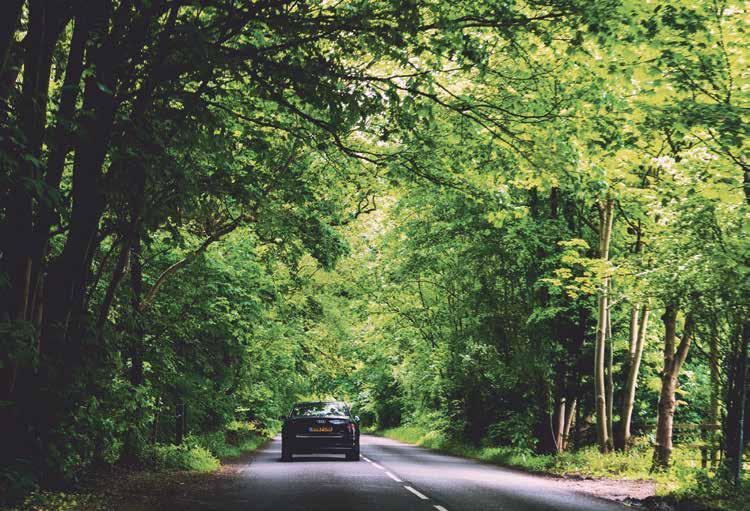
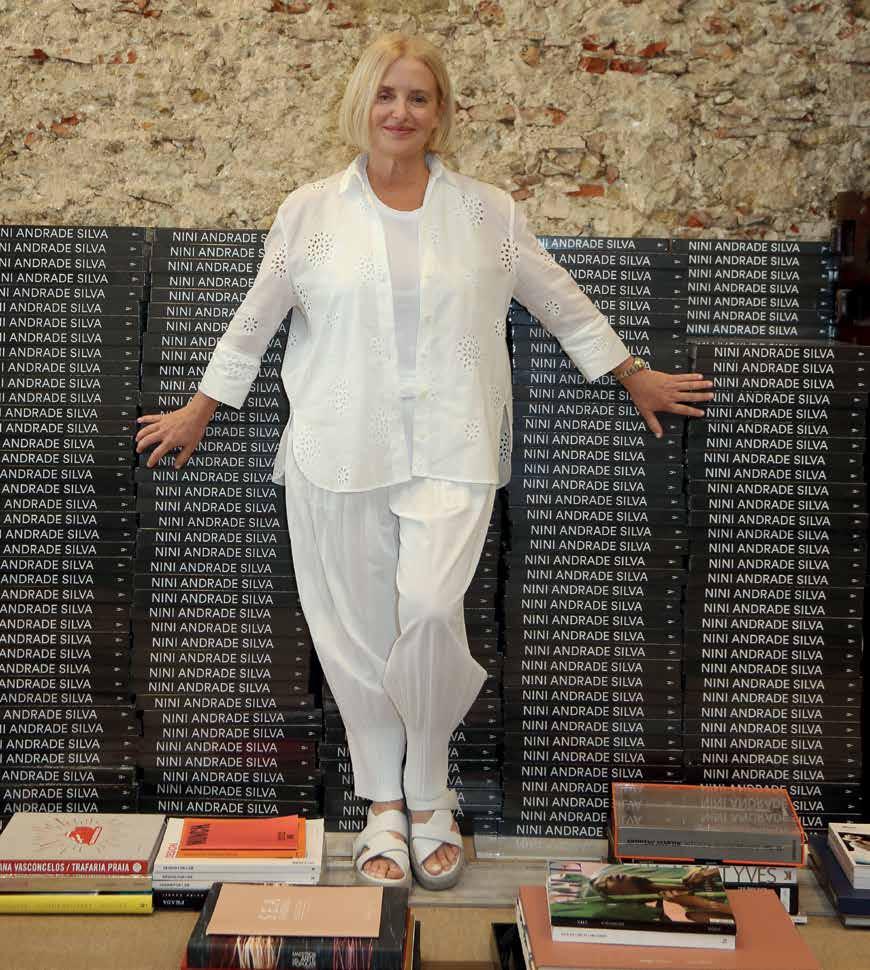
We were welcomed by the interior designer Nini Andrade Silva in a soft voice and dressed in white at her studio in Lisbon to discuss her career and devotion to God and Art. Who is the ‘last minute girl’ from Madeira who one day dreamed, moulded and gave life to an empire built to give a soul to hotels?

Por detrás de uma fachada discreta, igual a muitas outras da zona de Alfama, está o atelier de Nini Andrade Silva em Lisboa, mesmo atrás da Sé. Passa despercebido por fora, mas lá dentro a história é outra: há o rebuliço de uma equipa criativa a trabalhar, um canto com filas de tecidos de diferentes cores e texturas, e uma ou outra peça peculiar que não nos deixa esquecer que estamos num lugar onde se cria e se vive da inspiração. No fundo, o atelier é uma espécie de metáfora para a designer: com um exterior discreto e sereno, o interior pulsa com a criatividade e o caos indissociáveis da mente imparável de um artista.
Nascida Isabel Maria, na Ilha da Madeira, Nini partilha que soube desde pequena que a sua vida seria ligada à arte, independentemente da forma escolhida para se expressar: “Nasci para criar, tenho a certeza disso. Quando era miúda comecei a dizer a toda a gente que ia ser artista.”
Deste “chamamento” artístico resulta uma formação em Design, em Lisboa, à qual se seguem alguns anos a trabalhar em países como Dinamarca, África do Sul ou Estados Unidos da América. É mais tarde que, já regressada a Portugal, um trabalho na Lux Decor, na Cordoaria Nacional, a coloca no caminho da hotelaria. O projecto na Cordoaria Nacional valeu-lhe um convite de Diogo Vaz Guedes para fazer o Aquapura Douro Valley – actualmente Six Senses Douro Valley – e, a partir daí, fez da natureza efémera dos hotéis a sua arte permanente. Mas por que razão escolher para carreira um conceito que para a maior parte da população é só um local de passagem? “Trabalhar com ho-
téis é um mundo de criatividade sem fim a nível artístico. Posso estar sempre a experimentar coisas novas. E um bom hotel é uma casa fora de casa.” Como uma criança no recreio da escola, aqui dá para “brincar” com a imaginação, sem obstáculos no momento da criação, onde assume quase um papel de “Deus artístico”, que dá vida a algo que não existia.
Voltemos ao atelier. Aqui, neste espaço fértil de criatividade, um ventre que dá vida projectos inovadores e onde tudo o que respiramos é Nini, tentamos perceber de onde nasce a inspiração.
Diz-nos que pode estar em tudo, e, frequentemente, é no mais mundano e irrelevante dos objectos que encontra uma ideia de última hora. “Costumo chamar-me “last minute girl” porque, às vezes, temos um projecto já praticamente definido e eu à última da hora dou um “twist”, só porque me lembrei de que podia fazer uma coisa gira com uma caixa de cartão, por exemplo.” E, depois, o mar. “Sou da Madeira. Cresci com a infinitude do mar à minha volta. Sei que esse horizonte azul, sem ter nada que me bloqueie, influenciou e ainda influencia a minha liberdade criativa.”
É então que, conquistado com este metafórico horizonte de liberdade, surge o “Ninimalismo”: minimalismo e simplicidade, com carácter e alma. Assim se define o estilo artístico de Nini Andrade Silva, num conceito criado em tom de brincadeira, mas que já é bem familiar para muitos ouvidos.
Mas não nos deixemos iludir com a ideia de que ter um estilo próprio não implica fazer projectos que são a antítese da identidade artística de Nini. Aqui, como é que se encontra o equi-
Com uma voz serena e vestida de branco, a designer de interiores recebeu-nos no seu atelier de Lisboa para falar sobre a sua carreira, o que a inspira e a devoção a Deus e à Arte. Quem é a “last minute girl” madeirense, que um dia sonhou, moldou e deu vida a um império feito para dar alma a hotéis?Texto Text: Madalena Guinote Ramos DR Foto: Nick Bayntun
líbrio entre a exigência do cliente e o perfil da designer? O recentemente inaugurado Dos Reis Beautique Hotel, onde “mais é mais” e o minimalismo fica à porta, é o exemplo perfeito da artista a sair da sua zona de conforto. “Quando iniciamos um projecto temos de começar sempre com uma história. E, neste caso, a localização – a multicultural e vibrante Avenida Almirante Reis – foi o ponto de partida para um espaço mais arrojado e que se quer impor”, acrescentando que “o mais importante é o nível de confiança que o cliente deposita no artista.”

Católica devota e igualmente crente na importância que a Arte tem para o Homem, a roupa branca que traz vestida não nos deixa evitar a tentação de fazer um paralelismo com a pureza e inocência associada à religião. Contudo, talvez, seja mais correcto pensar no branco da roupa da artista como uma tabula rasa, tal e qual os hotéis que cria, à espera de ser preenchida com as cores e traços da sua inspiração. Seja ela divina ou não.
Nini Andrade Silva navega o mar do design de interiores com a confiança e conforto de quem já adquiriu a sabedoria que os vários anos de trabalho lhe deram, mas o arrojo e a capacidade de improviso da “last minute girl” ainda nos faz ansiar pela próxima vez que, com astúcia e inesgotável criatividade, nos apanha desprevenidos. Haja fé na infinitude de inspiração que ainda está por vir.
Behind a discreet façade like so many others in the Alfama neighbourhood, is Nini Andrade
Silva’s studio tucked away behind the Sé cathedral. From outside you hardly notice it, but it is quite a different story within; there is the buzz of a creative team at work, a corner with reams of cloth in different colours and textures, and one or other particular piece that reminds us that we are in a place of creation which lives from inspiration.
At its core, the studio is a kind of metaphor for the designer: with a discreet and calm exterior, an interior pulsating with creativity and the chaos which cannot be separated from the unstoppable mind of an artist.
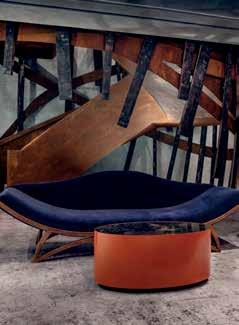
Born Isabel Maria, on the island of Madeira, Nini confides that she knew from a very young age that her life would be linked to art, regardless of the form chosen to express it: “I was born to create, of that I am certain. When I was a girl, I began to tell everyone that I would become an artist.”
Out of this artistic ‘calling’ was an education in Design in Lisbon which was followed by several years working in countries such as Denmark, South Africa, and the United States of America. Later, after returning to Portugal, a project at Lux Decor at the exhibition and events space National Cordoaria put her on the path to hotel interior design.
That project at the Cordoaria Nacional secured her an invitation from Diogo Vaz Guedes for the hotel project Aquapura Douro Valley - currently Six Senses Douro Valley - and from there made her art from the ephemeral nature of hotels permanent. But why did she choose a concept, which for most of the population is just a stag-
Nasci para criar, tenho a certeza disso. Quando era miúda comecei a dizer a toda a gente que ia ser artista.
I was born to create; of that I am certain. When I was a girl, I began to tell everyone that I would become an artist”.DR Foto: Nick Bayntun DR Foto: Jose Cunha
ing post, for a career. “Working with hotels is an endless world of creativity at an artistic level. I can always be trying out new things. And a good hotel is a home from home.”Just like a child in the school playground, here you can ‘play’ with imagination, without obstacles at the moment of creation, where you almost take on the role of an ‘artistic God,’ that gives life to something that hadn’t existed. Let’s return to the studio. Here, in this fertile creative space, a womb that gives birth to innovative projects and where everything we breathe is Nini, we try to fathom where this inspiration was born. She tells us that it can be in everything, and
frequently it is in the most mundane and irrelevant of objects that a flash of inspiration comes to mind at the 11th hour. “They often call me the ‘last minute girl’ because sometimes we’ve got a project practically defined and then at the 11th hour, I give a ‘twist’, simply because I realise that I could do something really nice with a cardboard box, for example.” And then there’s the sea. “I am from Madeira. I grew up with the infinity of the sea around me. I know that this blue horizon, while having nothing that could block me, influenced, and still influences my creative freedom.”
And so, by conquering this metaphorical horizon of liberty ‘Ninimalism’ came about: minimalism and simplicity, with character and soul. This is what defines the artistic style of Nini Andrade Silva, a concept created in a playful tone, but is already quite familiar to many ears.
But she doesn’t let us kid ourselves with the idea that having your own style does not mean doing projects that are the antithesis of Nini’s artistic identity. So how does she manage to strike a balance between the demands of the client and the profile of the designer? The recently inaugurated Dos Reis Beautique Hotel where minimalism “more and more” is left at the door, is the perfect example of an artist getting out of her comfort zone. “When we begin a project, we should always begin with a story. And in this case, the location - the multicultural and vibrant Avenida Almirante Reiswas the starting point for a bolder space which aims to ‘make a statement’, adding “the most important thing is the level of confidence that the client places in the artist.”

A devout Catholic and equally a believer in the importance that Art has for Mankind, the white clothing she is dressed in cannot help but make us draw a parallel with the purity and innocence associated with religion. Perhaps, however, it might be more correct to think of the artist’s white clothing as a blank canvas, just like the hotels that she creates, waiting to be filled with colours and the outlines of her inspiration Whether divinely inspired or not, Nini Andrade Silva navigates the seas of interior design with the confidence and comfort of someone who has acquired the wisdom that several years of work has afforded her, but the ‘last minute girl’s’ boldness and capacity for improvisation makes us eager to wait for the next time that she catches us unaware with her ingenuity and inexhaustible creativity. Let us have faith in the infinite inspiration that is still to come from Nini Andrade Silva.

Em vinte anos a trabalhar com os mercados imobiliários internacionais, julgo que nunca vi tantos factores adversos no horizonte. Os investidores enfrentam enormes desafios pela frente, ainda mais que na crise financeira de 2008. Ora vejamos. Nas grandes cidades internacionais, a racionalização das áreas de escritórios por parte das empresas está a levar uma enorme baixa não só na procura como uma ainda maior exigência à qualidade dos espaços. Acrescentemos a esta dificuldade as exigências das várias autoridades em níveis cada vez mais exigentes de critérios ambientais, e temos a tempestade perfeita para quem tem que entender o verdadeiro valor de um edifício de escritórios.
Durante a época Covid, não concordei com as várias declarações da morte do escritório, mas depois de um regresso ao local de trabalho, o pêndulo parece estar a voltar e embora não esteja ferido de morte, precisa de cuidados continuados. Desde o princípio do ano, nos EUA gestoras como a Blackstone e Brookfield entraram em default em grandes portefólios de escritórios que simplesmente já não valem tanto quanto os empréstimos que lhes estão afectos. Nos mercados de logística, as perspectivas do lado da procura continuam fortes, mas os promotores viram o valor dos seus projectos cair significativamente por força do aumento da taxa de desconto. Alguns sentem enormes dificuldades em financiar os projectos tanto do lado do crédito como de investidores.
Na Europa, países anteriormente considerados “fortaleza”, agora sofrem as consequências das altas taxas de juros, da guerra na Ucrânia, da subida dos preços da energia e de outras dinâmicas locais, estão a transformar países como a Suécia e a Alemanha em
mercados em dificuldades.
Na maioria, os investidores estão parados. As carteiras de imobiliário estão recheadas e com problemas para resolver. Poucos investidores procuram novos investimentos e o financiamento por parte dos bancos está em recuo. As instituições financeiras têm menos risco disponível para financiar imóveis e muito menos ainda para projectos de construção.
Dados recentes indicam que o financiamento de projectos residenciais na Alemanha caiu mais de 50% nos últimos 12 meses e o capital investido em fundos globalmente caiu 46% desde o primeiro trimestre de 2022.
O pouco que os investidores têm alocado nos últimos 12 meses, e correctamente no meu entender, tem-se concentrado na dívida. Grandes fundos de crédito imobiliário estão a ser criados na busca de juros mais altos ao tomarem o lugar dos bancos.
Nos mercados residenciais, destino de muito investimento nos últimos 10 anos, principalmente no residencial para arrendamento, a tentação dos políticos em requentar fórmulas falhadas do passado de controlo das rendas, tem ajudado a afastar investidores que não querem correr o risco reputacional.
A cobrir todos estes factores como um manto de negatividade, temos o tema da inflação e subida das taxas de juro que tenho referido em artigos passados. Talvez no passado, o efeito contrário – taxa de juro baixas e baixa inflação -, tenha servido para lavar todos os pecados dos maus investimentos. Desta vez, não temos esses ventos favoráveis e teremos que ser muito mais exigentes com os pressupostos de qualquer negócio.
A todos os leitores, não deixem que a minha visão mais pessimista vos tire o entusiasmo do Verão. Os meus desejos de umas boas férias!

In twenty years of working in international real estate markets, I don’t think I’ve ever seen so many adverse factors on the horizon. Investors face enormous challenges ahead, even more so than in the financial crisis of 2008.
In large international cities, companies’ rationalization of office space is leading to a huge drop not only in demand but also more stringent criteria of the quality of space. Add to this difficulty the requirements of the various authorities in increasingly demanding levels of environmental criteria, and we have the perfect storm for anyone who is underwriting the true value of an office building. During the covid era, I disagreed with the various declarations of the death of the office but, after a return to the workplace, the pendulum seems to be swinging back and even though the office is not dead, it needs continued care. Since the beginning of the year, large fund managers like Blackstone and Brookfield have defaulted on large portfolios of US offices that are simply no
longer worth as much as the loans assigned to them.
In the logistics markets, prospects on the demand side remain strong but developers have seen the value of their projects drop significantly due to the increase in the discount rate. Some developers experience enormous difficulties in financing projects both from the credit side and from equity investors.
In Europe, countries previously considered “fortress” countries, now suffer the consequences of high interest rates, the war in Ukraine, rising energy prices and other local dynamics that are changing once “safe” countries like Sweden and Germany into problem markets.
For the most part, investors are at a standstill. Real estate portfolios are full and with problems to solve. Few investors are looking for new investments and bank financing is in retreat. Financial institutions have less risk available to finance real estate and even less for construction projects. As an example, recent data in Germany tells us that financing for residential projects has fallen by more than 50% in the last 12 months and capital invested globally in funds has fallen by 46% since the first quarter of 2022.
The reduced investor allocations in the last 12 months, have been concentrated on debt and correctly so in my opinion. Large real estate credit funds are being created in search of higher interest rates, taking over the role banks play.
In the residential markets, a destination of a great deal of capital in the last 10 years, namely in residential for rent, the temptation of politicians to rehash past failed formulas of rent control, has helped drive away investors who do not want to deal with the associated reputational risk.
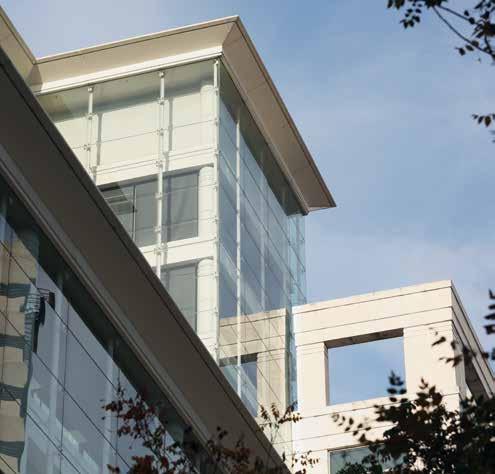
Covering all these factors like a blanket of negativity, we have inflation and rising interest rates that I have mentioned in past articles. Perhaps in the past, the opposite effect – low interest rates and low inflation, served to wash away all the sins of bad investments. This time, we don’t have those favourable winds and we will have to be much more demanding with of our assumptions on any investment.
To all our dear readers, don’t let my more pessimistic view dampen your summer enthusiasm. Wishes of a great holiday break!

Numa edição dedicada ao som do turismo, não posso ficar alheia e deixar de partilhar convosco a notícia das autoridades de Dubrovnik, na Croácia, sobre a restrição ao acesso de malas de viagens com rodas nas ruas antigas de paralelepípedos da cidade como medida preventiva para fazer face à diminuição da poluição sonora.
Parece-me uma opção interessante, não obstante, imagino o corrupio de turistas, sob temperaturas de 29º no Verão, a carregar as malas de viagem às costas até à porta do alojamento turístico, suando em bica. Certamente que o aumento de ordenados e gorjetas dos carregadores e transportadores de bagagem será inevitável, e bem pagos, não?! Até já consigo imaginar este cenário nas ruas de Alfama até ao Castelo, em Lisboa. Vocês não?
In this edition dedicated to the sound of tourism I just must share with you the news from the authorities in Dubrovnik, Croatia about the restricted access to travel baggage with wheels on the old, cobbled streets of the city as a preventative measure to reduce sound pollution.

It seems an interesting option, nevertheless I can imagine the corrupting tourists under summer temperatures of 29º, carrying luggage by hand to the door of their tourism accommodation, dripping with sweat. Certainly, there will be an inevitable increase in baggage carriers’ salaries and tips, and they’ll be well paid, won’t they?!
And I can already just see this scene in the streets of Alfama and Castelo in Lisbon. Can’t you?
Disponibilizamos soluções de seguros personalizadas para todas as etapas do processo constru�vo, com vista à sustentabilidade e proteção do seu negócio.
Trabalhamos hoje para que o amanhã exista.

As cidades do futuro constroem-se agora. Vamos construí-las juntos.

a mesma equipa com maior alcance e expertise .
Durante mais de 30 anos, a Predibisa foi líder incontestável de serviços de mediação Imobiliária Residencial e Comercial no mercado do Porto, proporcionando aos seus clientes o profissionalismo e a excelência intrínsecos à sua equipa.
A partir de agora, a oferta de serviços ao cliente terá a assinatura da rede global Savills, oferecendo a mesma excelência e rigor, aliados a novas oportunidades de negócio numa escala global, assim como a uma maior expertise.
A aposta nas equipas e serviços na região do Porto continuará a sua trajetória ascendente. Com as mesmas pessoas, defensoras da mesma ética e, como sempre, do mesmo compromisso para com os clientes.
savills.pt